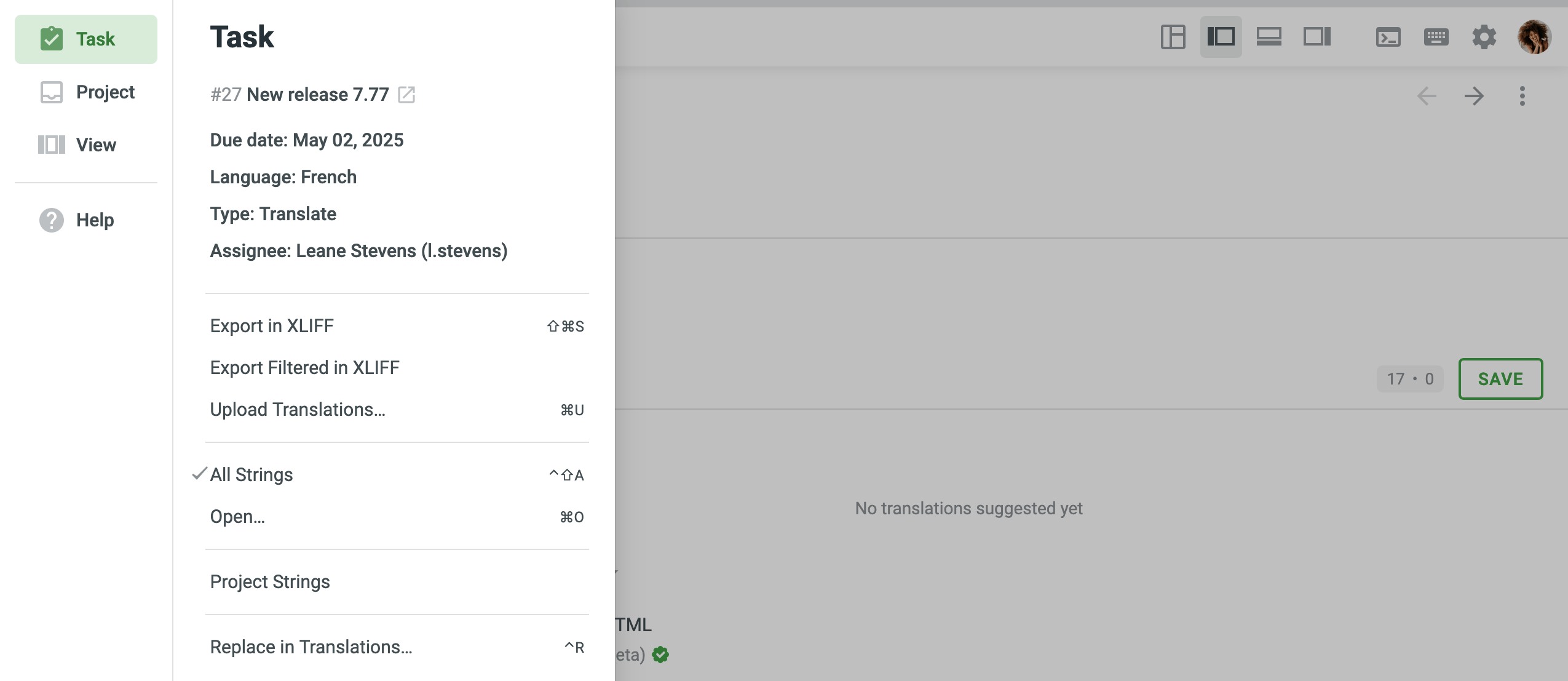Editor online
The Editor is the main place in Crowdin where project members can suggest, vote, and approve translations online. It can be viewed in Comfortable, Side-by-Side, or Multilingual mode. The Comfortable mode is enabled by default.
Using the Main menu ![]() in the upper-left corner, you can switch between files for translation, change translation languages, contact a manager, change the view, and access help materials.
in the upper-left corner, you can switch between files for translation, change translation languages, contact a manager, change the view, and access help materials.
Modalità Comoda
Comfortable mode is primarily used for translation and consists of four main sections:
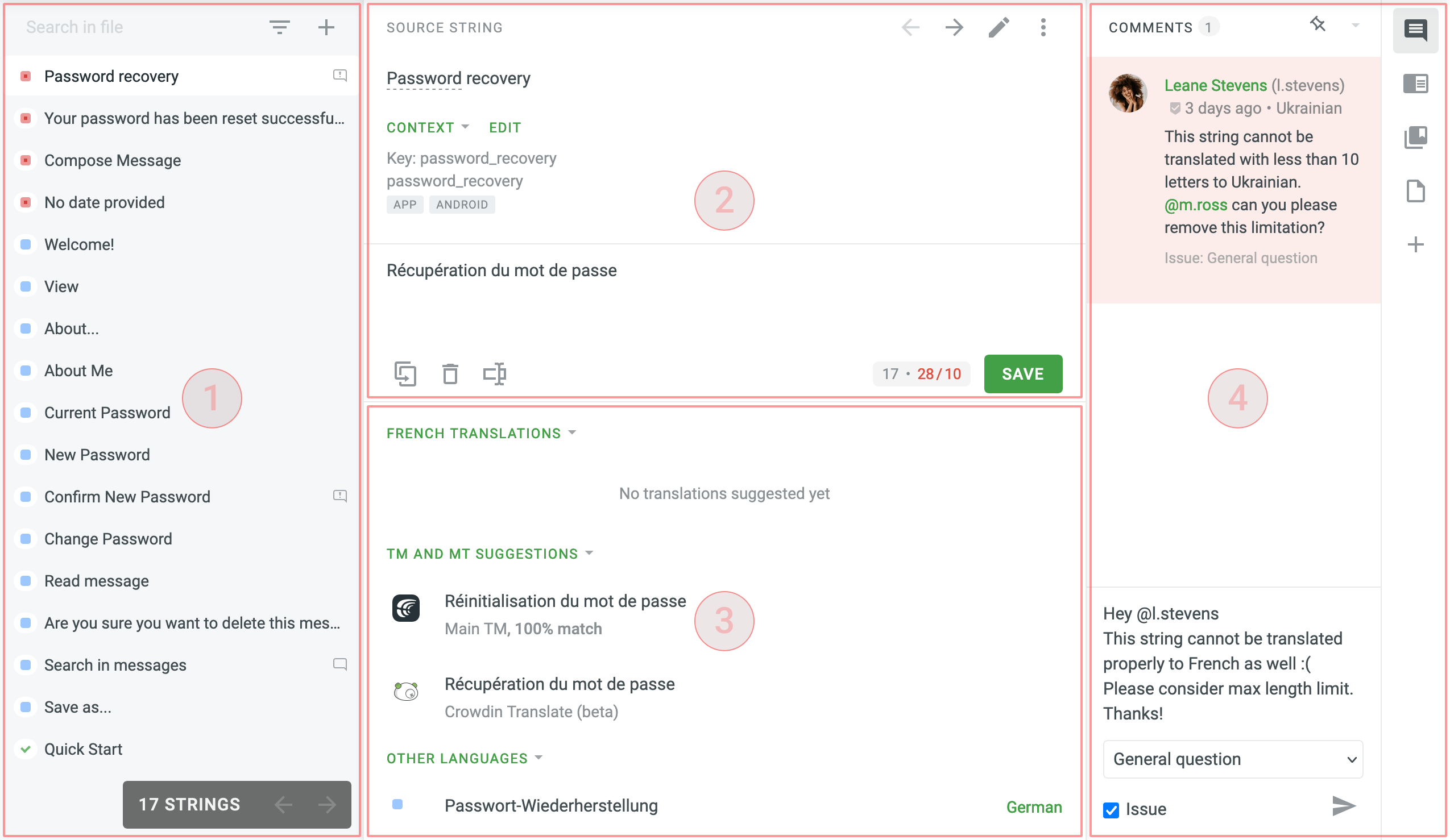
Section 1 - Left Sidebar
This section displays the list of strings, with the active one highlighted. Strings are text elements that are either individual words, phrases, or sentences. Some strings might have replacement tokens (e.g., {0}, {1}, %1, etc.) or elements of the ICU message syntax. Such items themselves should not be translated but are used by the website code to dynamically insert some information into strings. To work with such strings, you should copy the source string and translate only the real words.
Strings can have the following statuses:
 - non tradotta
- non tradotta - partially translated (if some of the plural forms are not translated)
- partially translated (if some of the plural forms are not translated) - tradotta
- tradotta - partially approved (if some plural forms are not approved)
- partially approved (if some plural forms are not approved) - approvata
- approvata - nascosta (visibile solo ai gestori del progetto ed ai proofreader)
- nascosta (visibile solo ai gestori del progetto ed ai proofreader)
Potrebbero anche esserci le seguenti icone oltre alle stringhe:
 - la stringa contiene commenti dai collaboratori
- la stringa contiene commenti dai collaboratori - la stringa contiene un problema irrisolto
- la stringa contiene un problema irrisolto
When translating the content of an HTML, XML, TXT, DOCX, XLSX, HAML, Web XML, Markdown, MDX, DITA, FLSNP, Wiki, ADOC, Coffee, FTL, JS, TS, and FTLH file formats, a list of strings is displayed as a file preview (i.e., WYSIWYG). The string status is indicated by the following colors:
- Rosso - non tradotto
- Blue - translated
- Light-green - approved
- Gray - not for translation
An active string is highlighted in yellow.
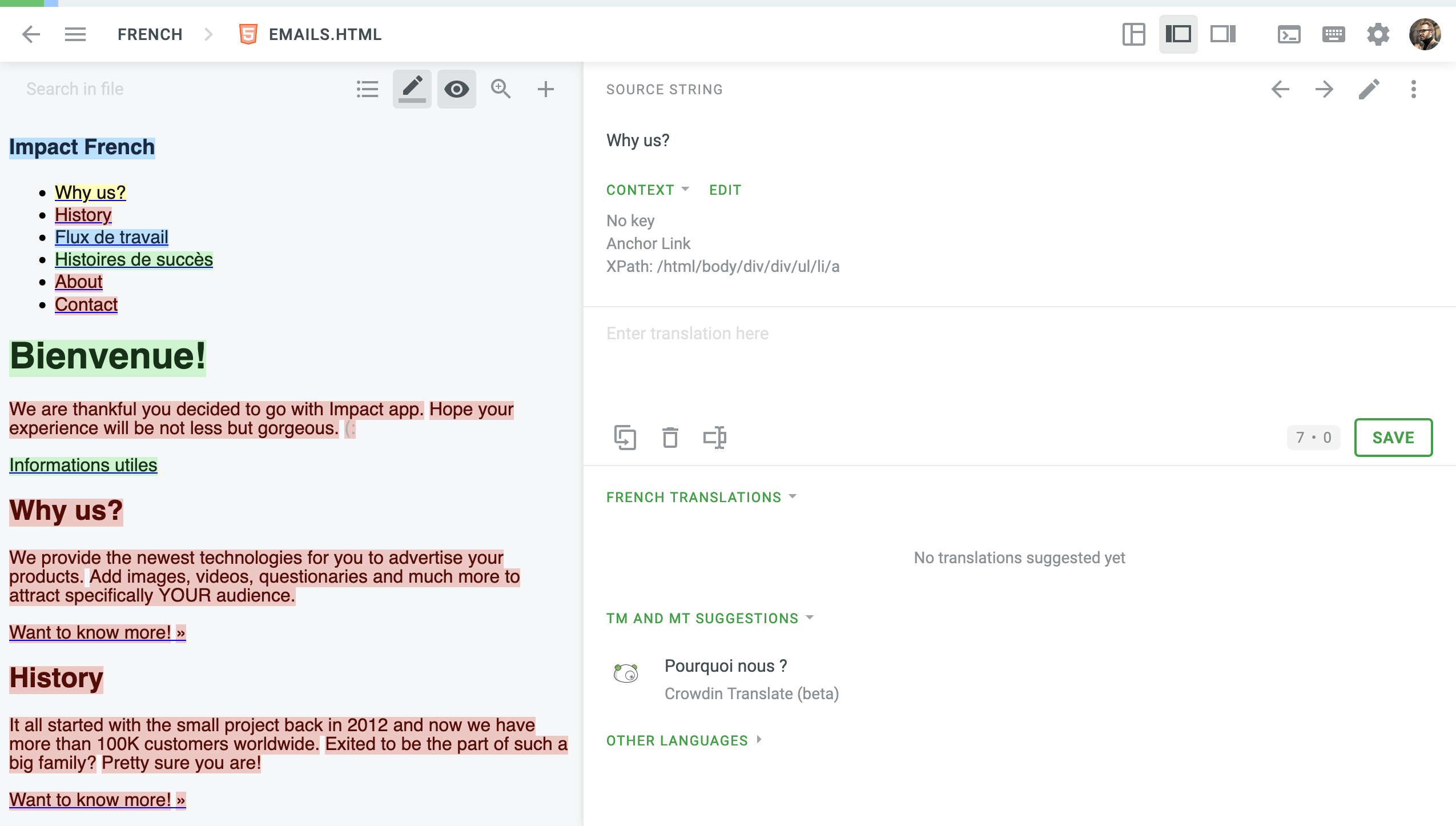
Le seguenti opzioni sono disponibili per gestire la suddetta vista:
 - Load basic list view. Use it to switch to a standard mode and see a list of strings.
- Load basic list view. Use it to switch to a standard mode and see a list of strings. - Highlight untranslated, translated, and approved strings. Use it to toggle the color highlighting of strings on and off.
- Highlight untranslated, translated, and approved strings. Use it to toggle the color highlighting of strings on and off. - Show translation preview. Use it to toggle the translation preview mode on and off.
- Show translation preview. Use it to toggle the translation preview mode on and off. - Scale Toggle. Use it to toggle between a zoomed-in and zoomed-out view.
- Scale Toggle. Use it to toggle between a zoomed-in and zoomed-out view.

Ricerca della Stringa
You can search for strings by source text, translations, context, or all at once. Depending on the content you open in the Editor, the system will search for matches within the currently open file or across all strings in the project.
Per cercare le stringhe nel file o nell’intero progetto, digita la tua frase di ricerca nel campo Cerca nel file (Ricerca stringhe). Puoi inoltre usare una scorciatoia da tastiera per passare al campo di ricerca (di default, Ctrl+F).
To refine the search results, you can use the following options:
- Match case – with this option, you will find only the strings written in the same case: for example, if you search for
Workand select Match case, the system will findWork,Works,Workingbut notwork. - Match whole phrase – with this option, you will find the strings containing the search phrase only in the original order: for example, if you search for
Machine Translationand select Match whole phrase, the system will findMachine Translation,Machine translation,machine translationbut notTranslation Machine. When Match whole phrase is not selected, the system splits the search phrase into separate words and searches for matches in the strings in any order. - Exact match – with this option, you will find only the strings that exactly match the search phrase: for example, if you search for
Workand select Exact match, the system will findWork,work, but notWorksorWorking.
Puoi combinare il Formato corrispondente con la Corrispondenza esatta e il Formato corrispondente con la Frase intera corrispondente. Frase intera corrispondente e Corrispondenza esatta sono opzioni reciprocamente esclusive.
La frase di ricerca è limitata a 128 caratteri. La frase di ricerca è limitata a 128 caratteri.
To search for strings by a numeric identifier, type the number without quotation marks, such as 34354, to find the exact match. To search for the occurrences of the number in the text or context, enclose the number in quotation marks when typing it in the search box, for example: “34354”.
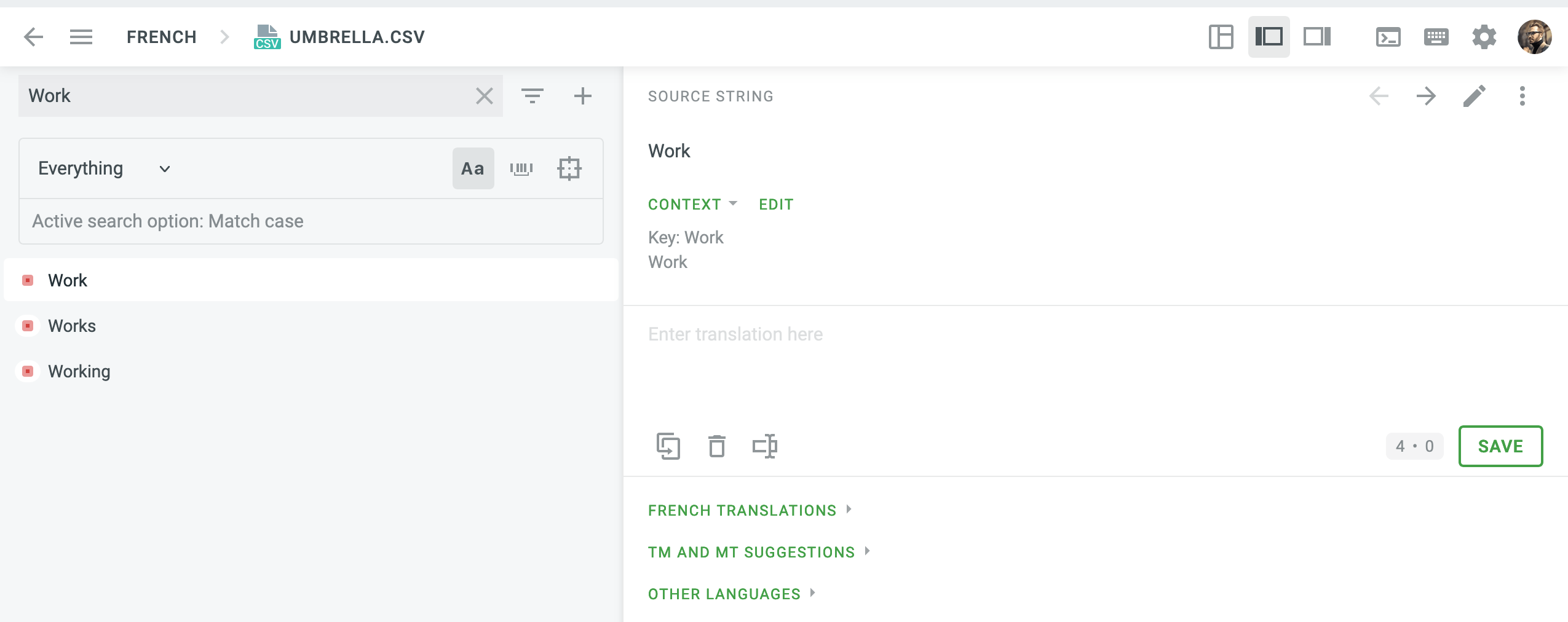
Filtering Strings
Per filtrare le stringhe mostrate nella barra laterale sinistra, clicca ![]() e seleziona l’opzione del filtro preferita.
e seleziona l’opzione del filtro preferita.
Opzioni di filtraggio disponibili:
- Show All – Show all strings from the open file/folder in their original order.
- Tutte, Non Tradotte Prima - Mostra tutte le stringhe dal file/dalla cartella aperto/a. Untranslated strings are displayed at the top of the list, followed by translated strings, and then approved ones are displayed at the bottom of the list.
- Non Tradotte - Mostra solo le stringhe senza alcuna traduzione.
- Da Votare - Mostra le stringhe già tradotte.
- Non Approvate - Mostra le stringhe che sono già tradotte ma non sono ancora state approvate da un proofreader.
- Approvate - Mostra solo le stringhe con traduzioni approvate.
- Problemi QA - Mostra le stringhe senza alcun problema QA o con problemi QA irrisolti nella lingua corrente.
- Traduzione Automatica - Mostra le stringhe tradotte dai suggerimenti della TM o della MT senza modifiche. Often these strings require additional review.
- Con Commenti - Mostra le stringhe aventi dei commenti.
- Con Problemi Irrisolti - Mostra le stringhe con problemi irrisolti nella lingua corrente o in tutte le lingue.
- Nascoste - Mostra le stringhe nascoste dai traduttori. Strings can be hidden by project managers or automatically hidden by Crowdin when they are marked as duplicates.
- Advanced Filter – Filter that allows you to configure custom filtering and sorting parameters.
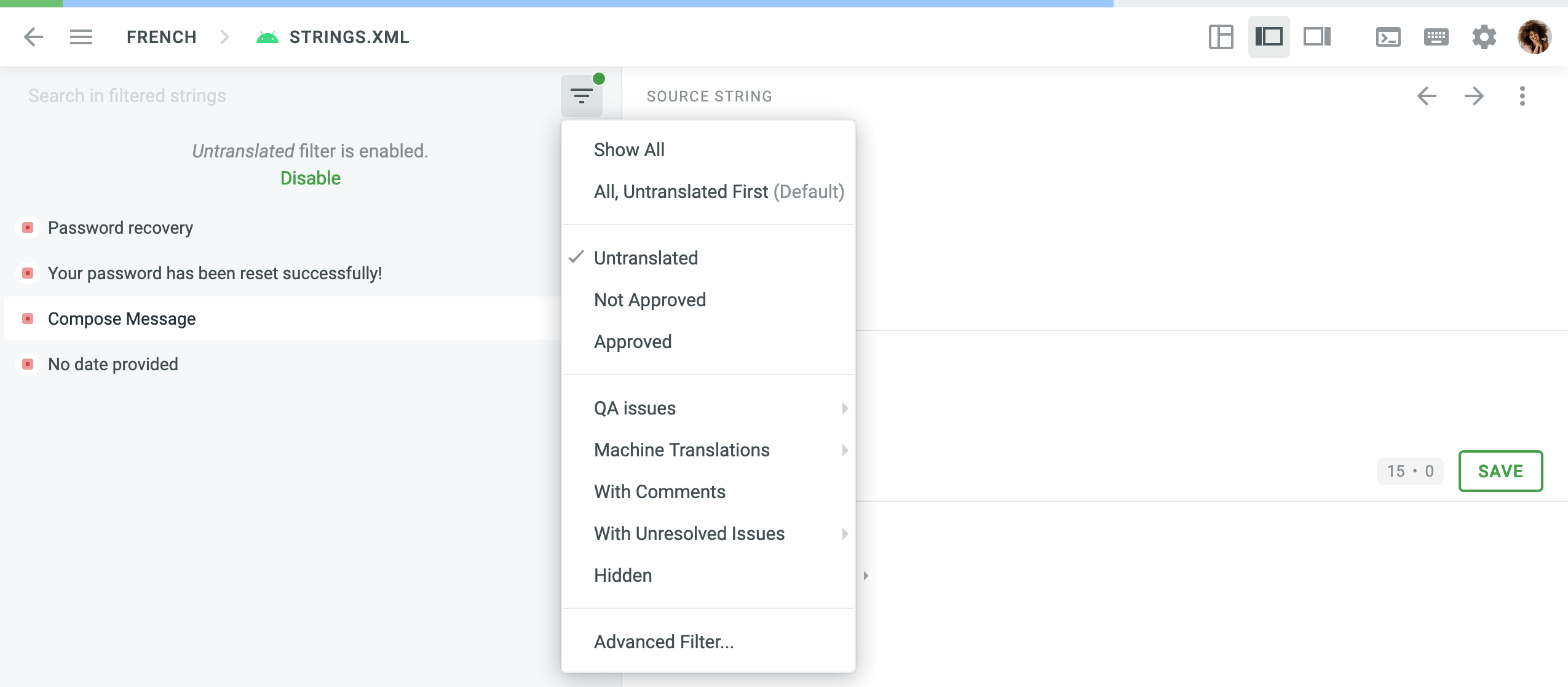
Espressioni Verbali
The Verbal Expression section of the Advanced Filter implements a regular expression search. Puoi impostare dei parametri di ricerca specifici per le stringhe nel tuo progetto. Puoi impostare dei parametri di ricerca specifici per le stringhe nel tuo progetto.
For example, if you want to extract all strings that start with an uppercase letter and have a period at the end, your expression might look like this: start "true", range "A,Z", anything, range "a,z,A,Z,0,9", limit "1,50", then ".", end "true"
Let’s break down the above expression:
start "true" – indicates the beginning of the string. range "A,Z" – means that your string starts with characters in the range A-Z. range "a,z,A,Z,0,9" – means that your string can contain characters in the range a-z and/or A-Z and/or 0-9. limit "1,50" – means that the length of the string is between 1 and 50 characters. then "." – means that your string ends with a period. end "true" – indicates the end of the string.
Ecco alcuni altri esempi di casi d’uso di come puoi usare le Espressioni Verbali:
- Strings containing URLs:
then "http", maybe "s", then "://", maybe "www.", anythingbut " " - Stringhe con segnaposti
%se%d:then "%", anyof "s,d" - Strings with variables enclosed in double curly brackets:
then "{{", range "a,z", then ".", range "a,z", then "}}" - Strings that contain a floating point number:
start, range "0,9", multiple, then ".", range "0,9", multiple, end
Per configurare un’espressione verbale, usa la seguente sintassi dell’espressione.
Section 2 - Middle-Top Area
The main working area with the source string at the top and the translation section below. To add a translation, you need to select a string from the left section, and it will appear in the middle-top Source String field.
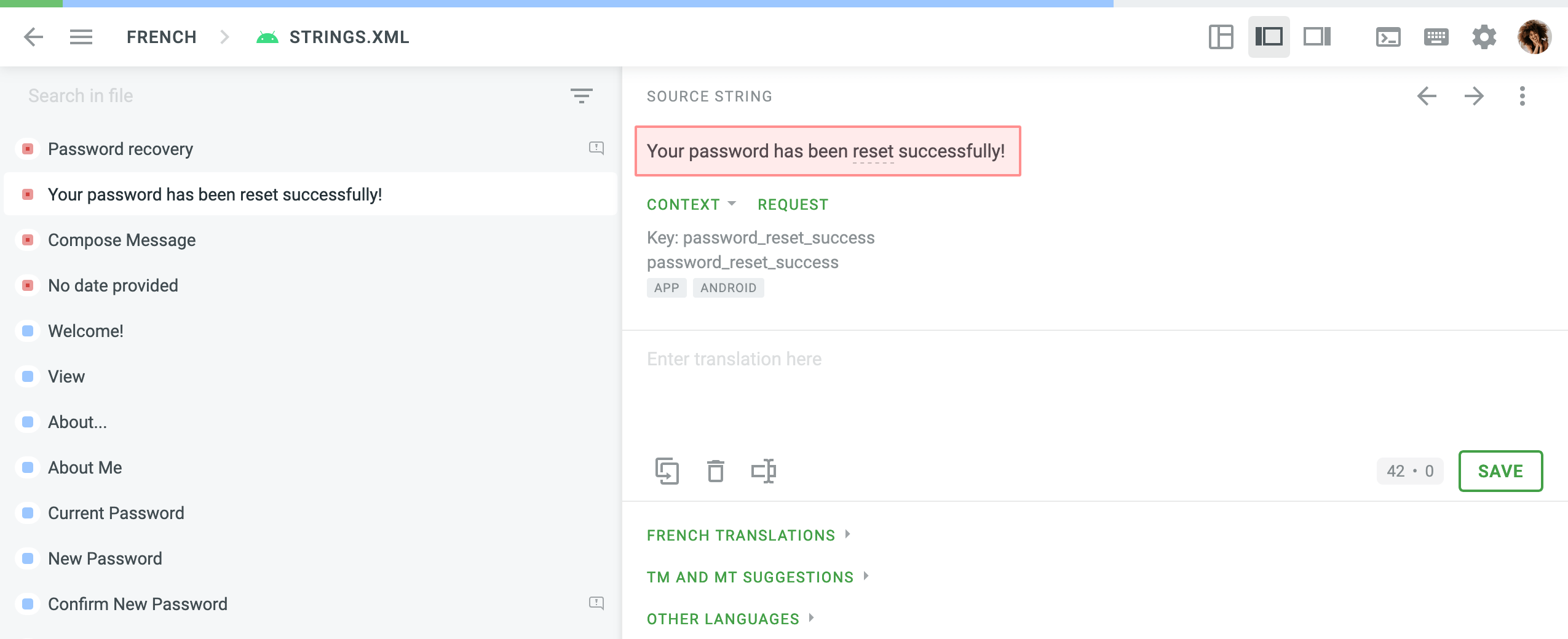
This area also displays the context of a string. Context can include the technical details, an explanation of where the line appears in the actual product, or a screenshot showing the location of the string in a user interface. If the source string has no context and it’s not clear how to translate it, click Request and a project manager will be notified that additional explanation is needed.

Some strings may have underlined words or phrases. This means that the word or phrase is part of the project terminology and should be translated according to the term description. You can view additional explanations added to the specific term for accurate translation. This can be done by hovering over the underlined text or by going to the Terms section in the right sidebar.
Some terms may have translations. Previously translated terms increase the consistency of project texts. To reuse the term translation, click on the underlined term, and its translation will appear in the translation field.
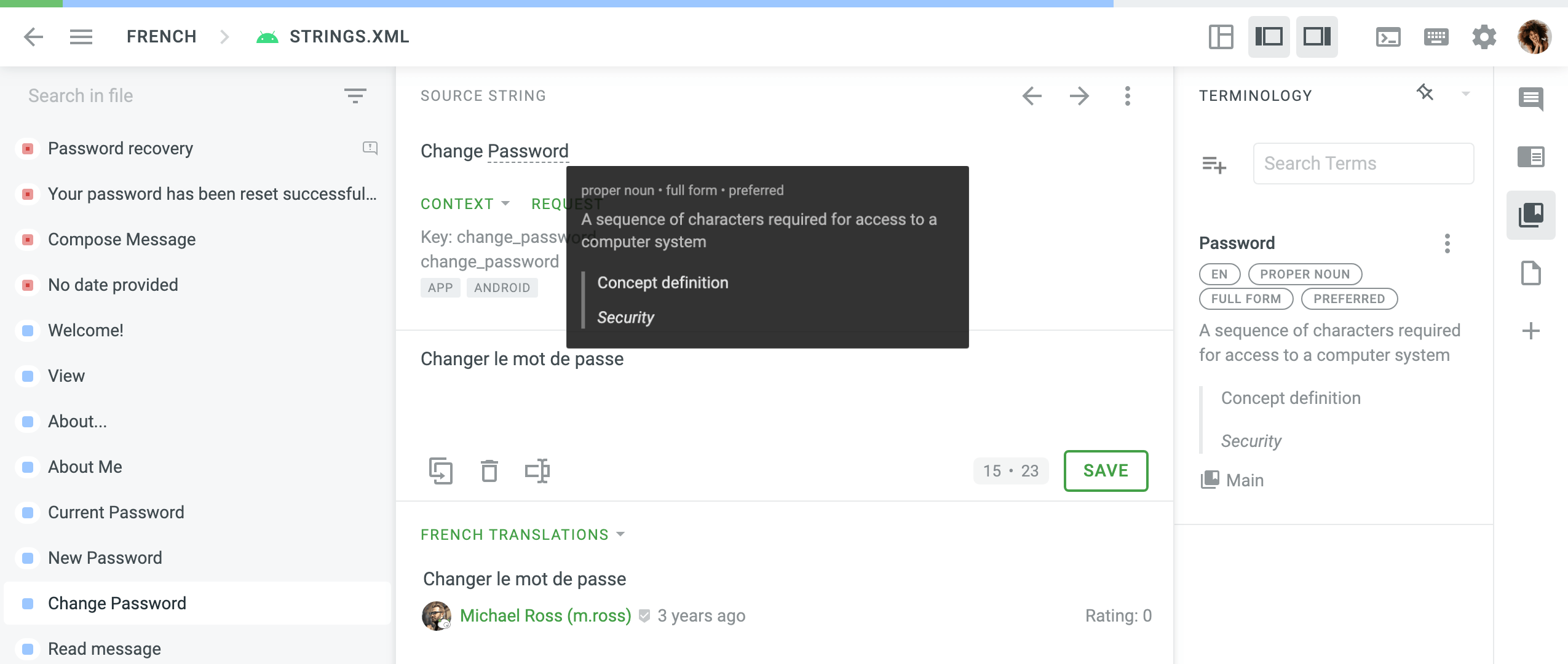
Enter the translation in the field below the original text in the middle section and click Save. Sarai reindirizzato automaticamente alla stringa successiva.
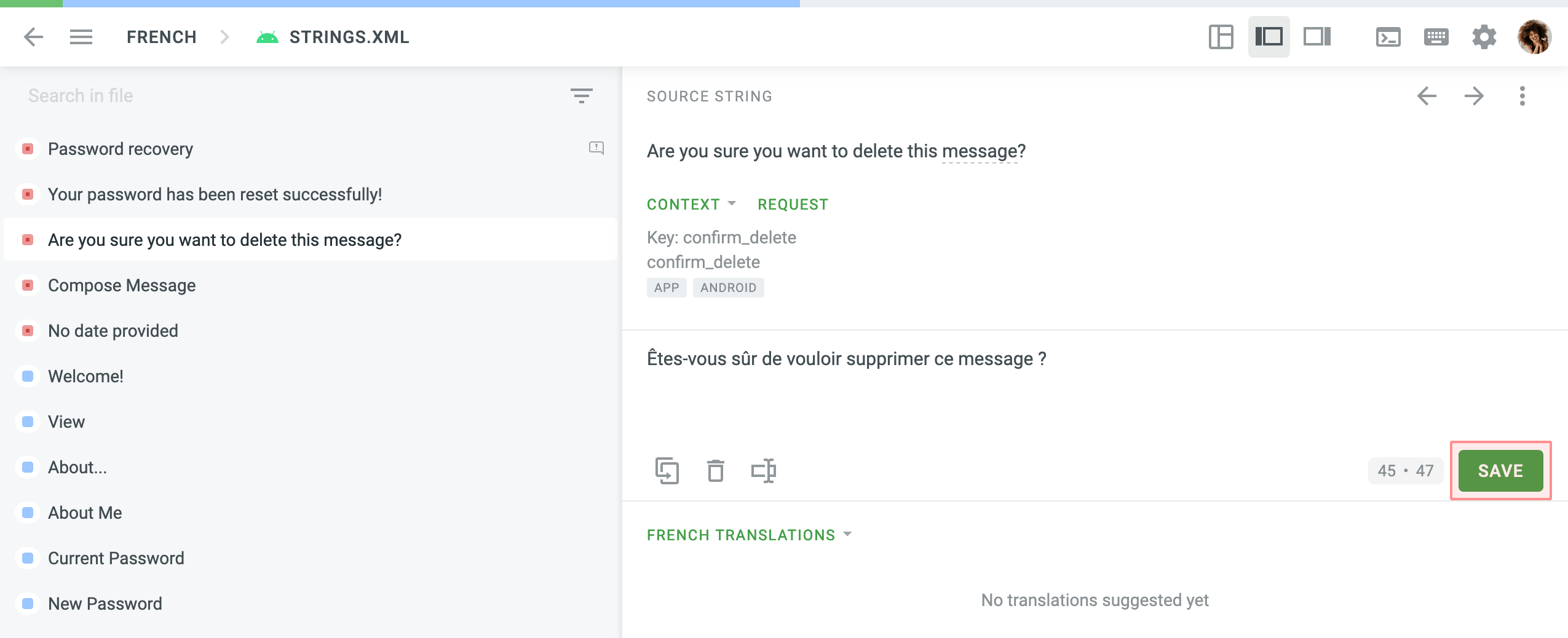
Forme Plurali
Alcune stringhe potrebbero avere forme plurali. A seconda della lingua, il numero di forme plurali potrebbe variare. For example, Chinese has one plural form, English has two plural forms, and other languages may have up to six plural forms. Crowdin works with plural forms according to the CLDR Language Plural Rules.
Read more about CLDR Language Plural Rules.
If a string has multiple plural forms, all variants of the string are displayed in the section where you type in translations. Enter translations in the appropriate tabs that display the plural forms of the target language.
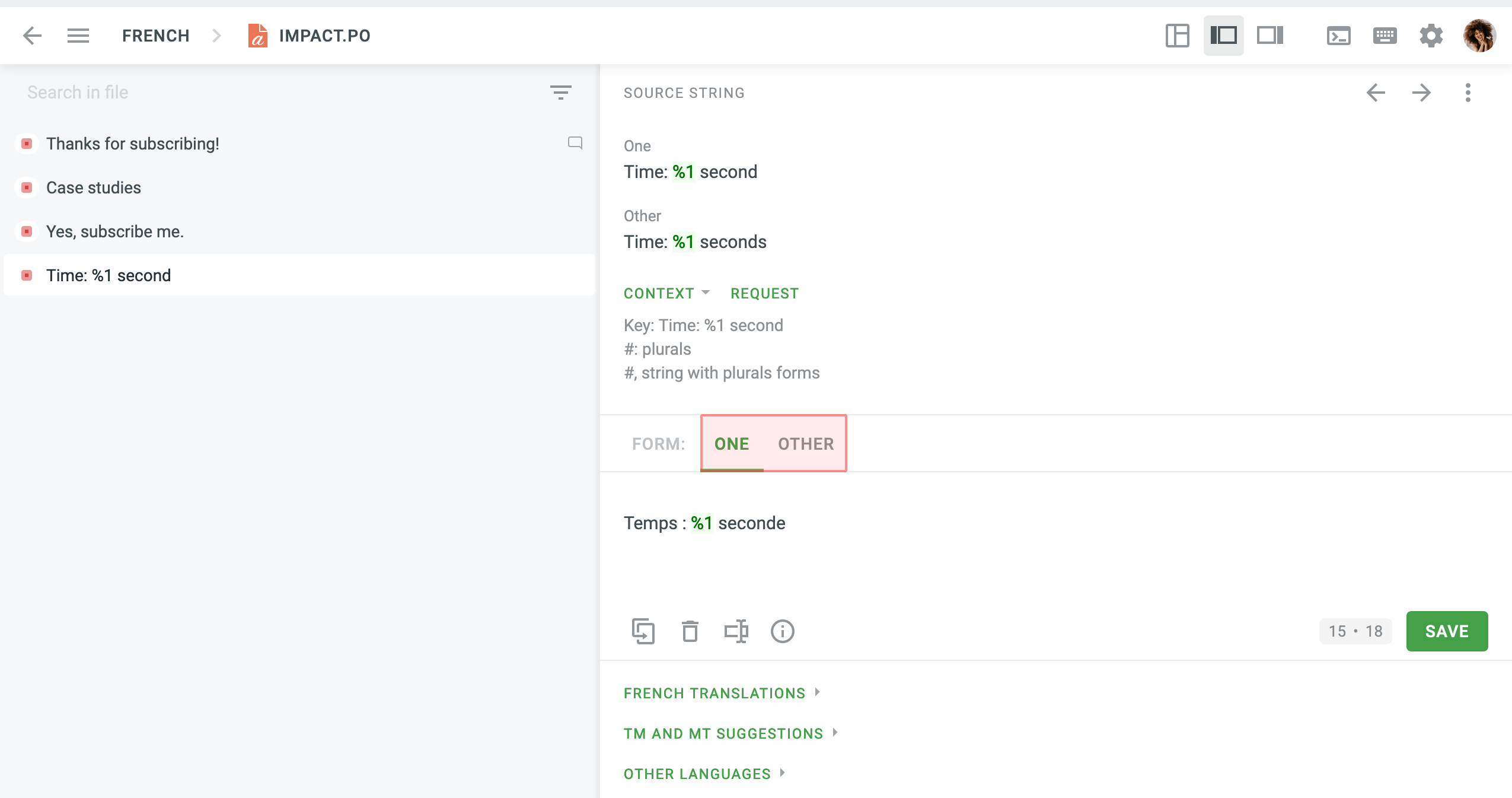
Potresti anche ottenere messaggi popup automatici di controllo di garanzia della qualità (QA) per evitare alcune inaccuratezze di traduzione. Ad esempio, puoi vedere delle notifiche sulle incosistenze nella punteggiatura, spazi non corrispondenti, variabili mancanti e altro.
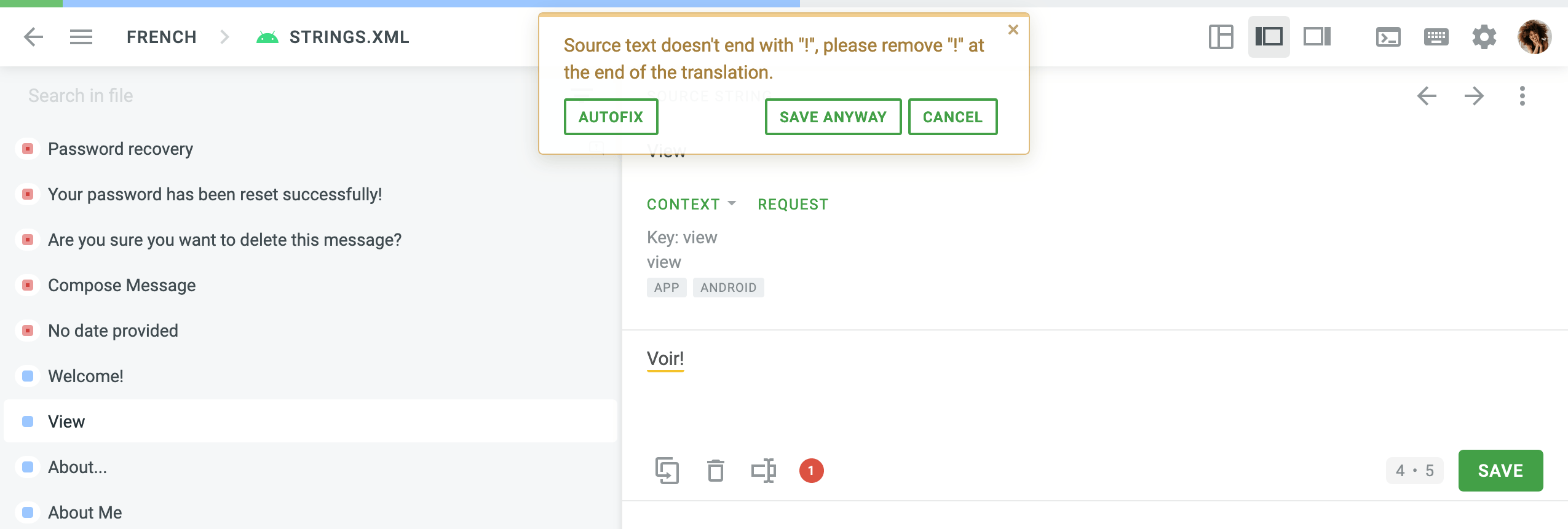
Clicking ![]() in the upper-right allows you to:
in the upper-right allows you to:
- Copy String URL to access a specific string using its unique link or share it with colleagues.
- Copy Source Skeleton to copy untranslatable elements to the translation section. Useful when translating strings with ICU message syntax and strings with HTML tags.
- Access Translation History to see all the modifications done to the string.
- View String In Context to display a string along with other strings surrounding it in the source file, which gives a better understanding of how the string should be translated.
Nella finestra di traduzione, vedrai inoltre il limite della Lunghezza massima di traduzione, se è superato.
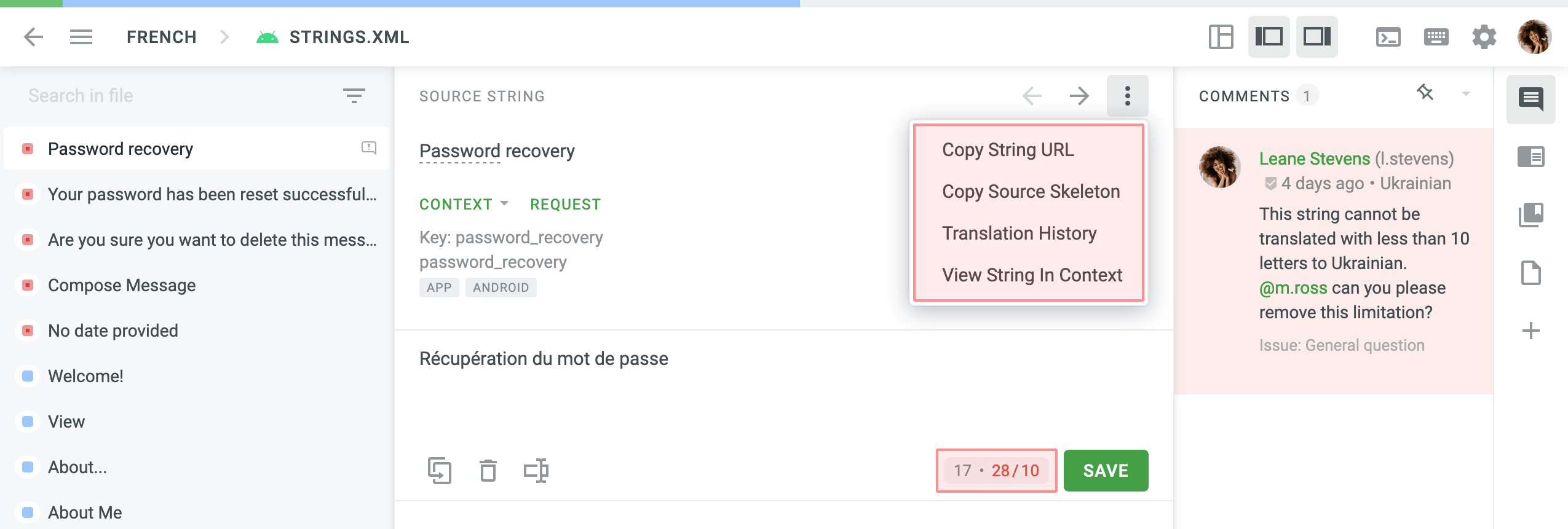
Additional buttons available in the translations section:
![]() - Copy Source. Use it to keep the initial string structure while translating messages with replacement tokens or elements of ICU message syntax.
- Copy Source. Use it to keep the initial string structure while translating messages with replacement tokens or elements of ICU message syntax. ![]() - Clear. Use it when you need to erase the whole suggestion quickly.
- Clear. Use it when you need to erase the whole suggestion quickly. ![]() - Text selection mode. Use it when you want to copy a part of the translation from Translation Memory (TM) or Machine Translations (MT).
- Text selection mode. Use it when you want to copy a part of the translation from Translation Memory (TM) or Machine Translations (MT).
Section 3 - Middle-Bottom Area
Questa sezione contiene delle risorse che potrebbero essere utili:
- Traduzioni da altri partecipanti al progetto
- Suggerimenti Memoria di Traduzione (TM)
- Suggerimenti di Traduzione Automatica (MT)
- Traduzioni verso altre lingue
Clicca su uno dei suggerimenti e apparirà automaticamente nel campo di traduzione. Refer to it as a basis for your own suggestions.
To quickly copy the TM or MT suggestion to the translation field and save it, click Use and Save ![]() on the desired suggestion.
on the desired suggestion.
La sezione Altre Lingue ti consente di verificare le traduzioni della stringa in altre lingue di destinazione. Questo può essere un utile aiuto per le persone multilingue e traducendo i dialetti di una lingua.
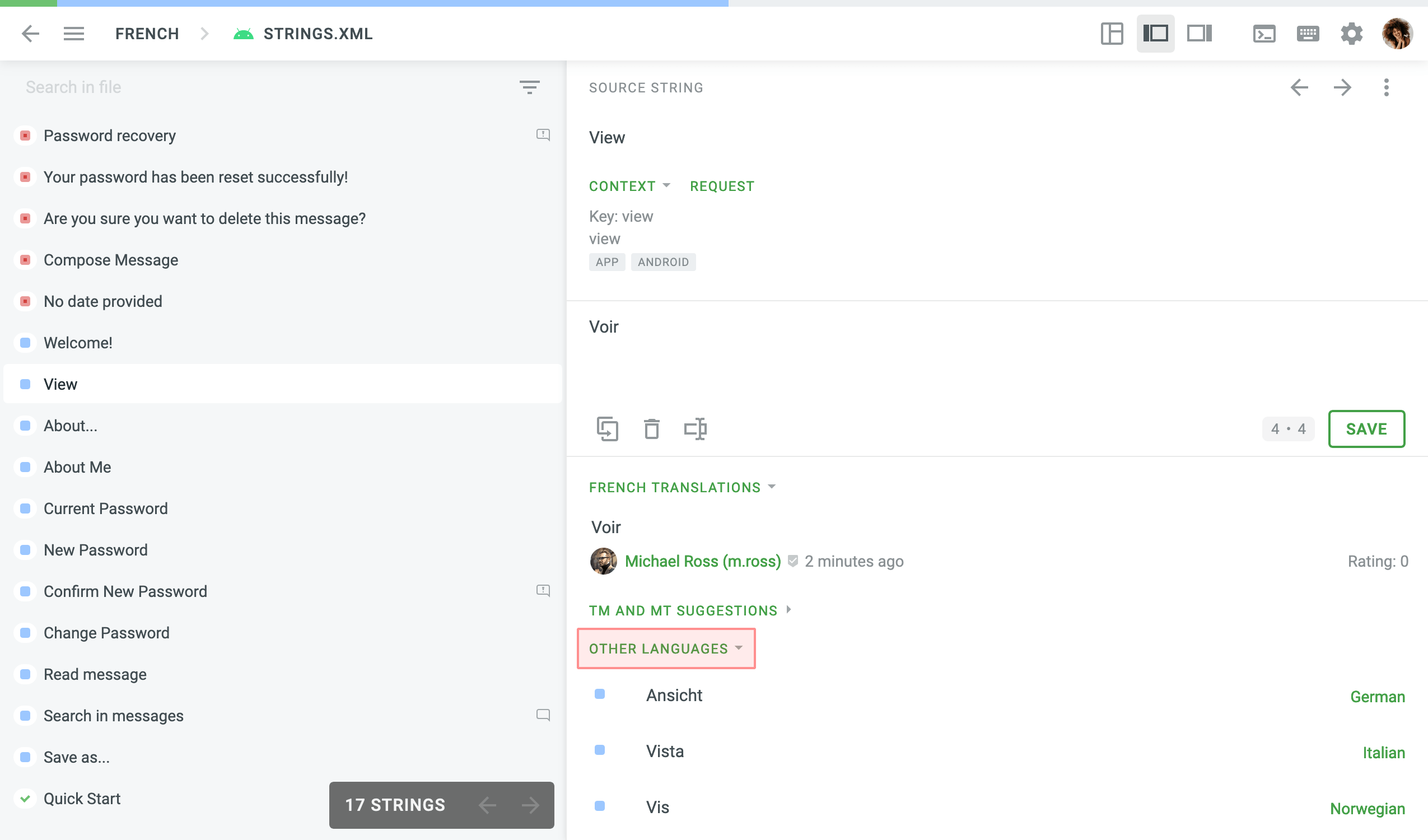
Se vedi che è già presente un suggerimento corretto, votalo. To vote for multiple translations, it would be more convenient to switch to Side-by-Side Mode.
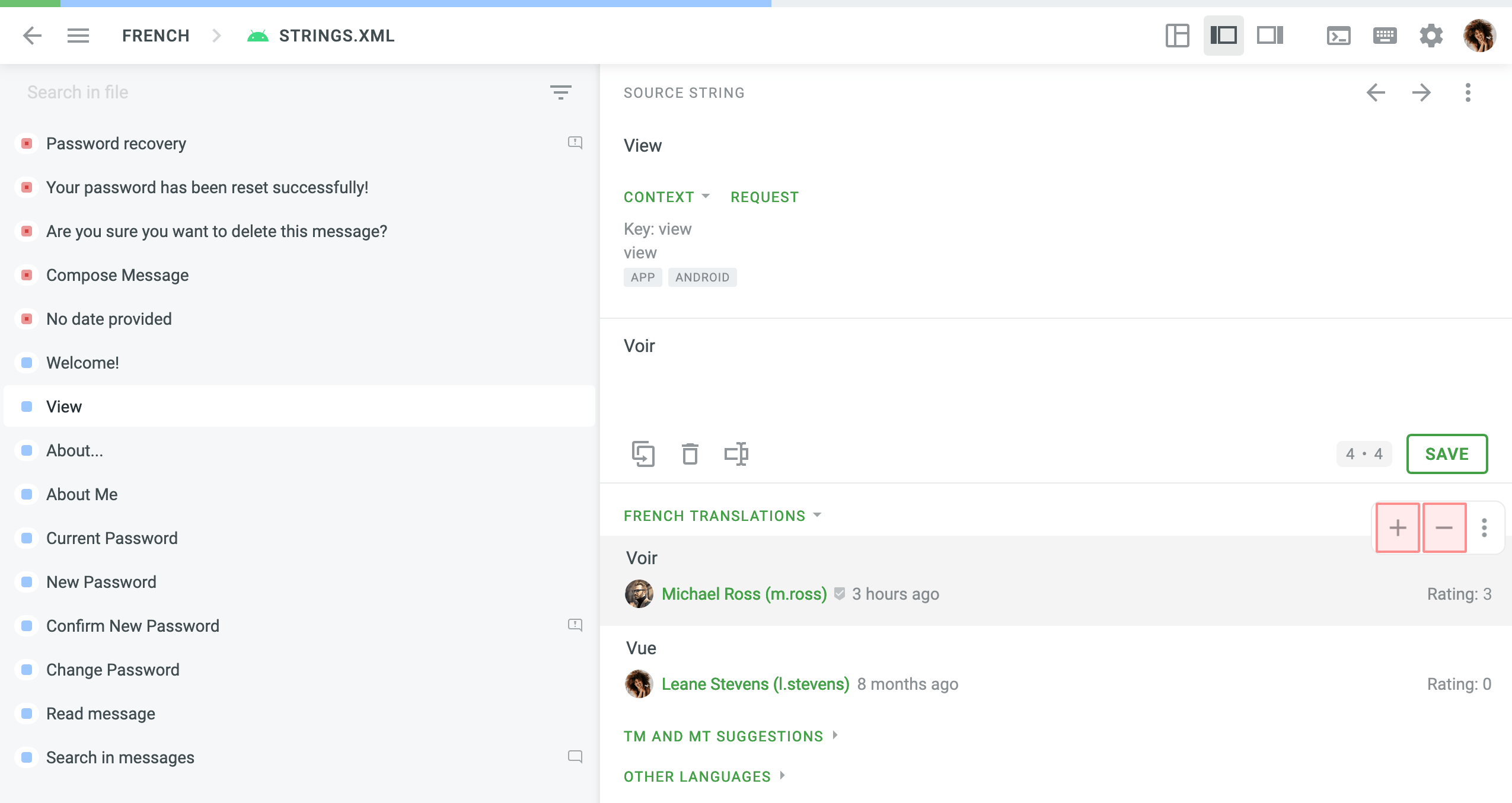
Se sei un revisore e pianifichi di revisionare e approvare più di una traduzione, passa alla Modalità Fianco a Fianco.
Section 4 - Right Sidebar
Commenti
Usando la scheda Commenti, puoi discutere del significato della stringa sorgente o altre domande correlate. It is recommended to use a source language of the project so other translators can understand it. Use “@” and a username to direct your message to the specific person.
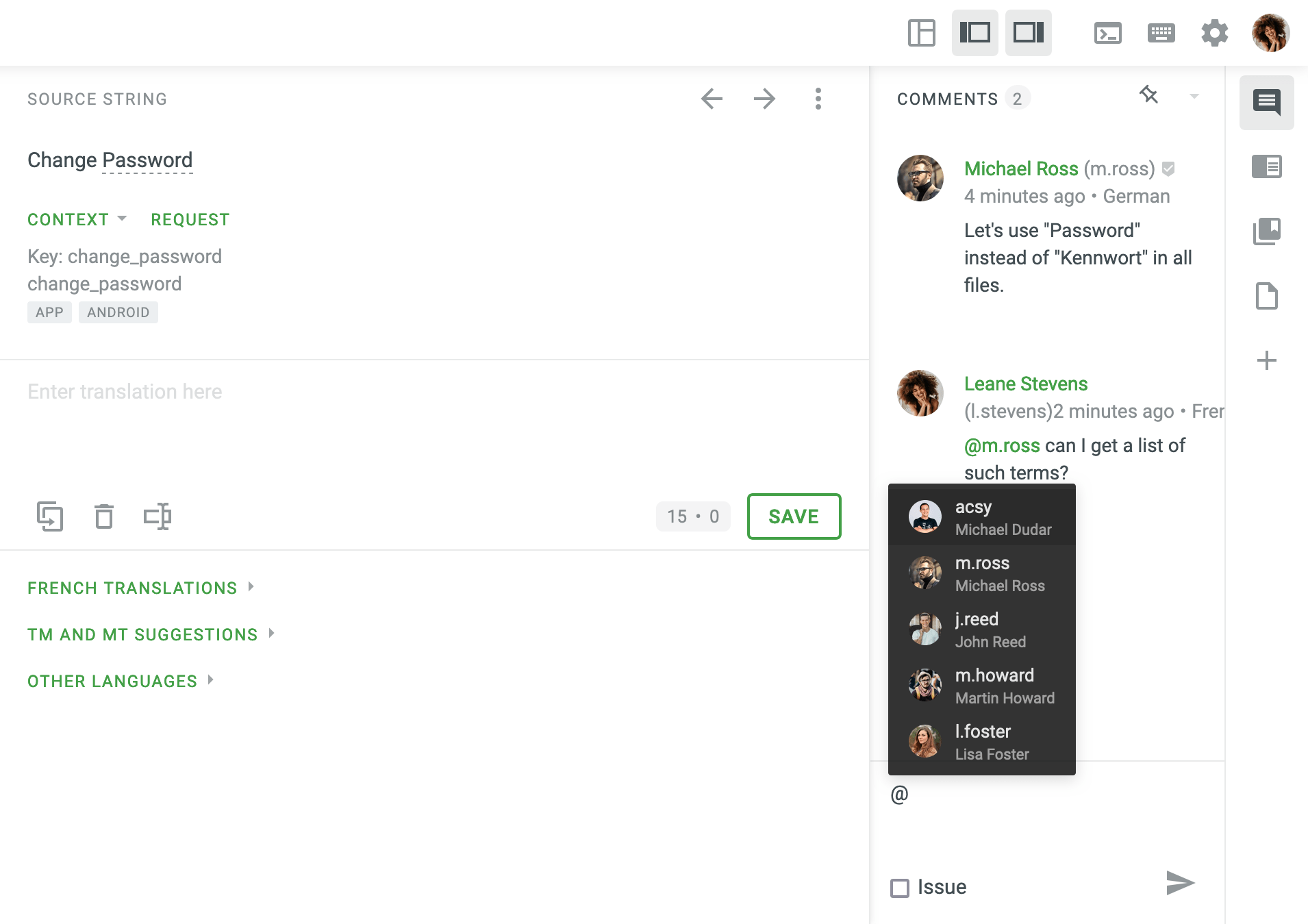
Segnalare Problemi
Inoltre, nella scheda dei Commenti, puoi segnalare i problemi relativi alle stringhe sorgente o alle traduzioni ai gestori del progetto, selezionando la casella di controllo Problema.
Tipi di problema disponibili:
- Domanda generale – Domanda generale correlata alla stringa sorgente o alle sue traduzioni.
- La traduzione corrente è errata – La traduzione aggiunta alla stringa sorgente è errata e richiede una correzione.
- Lack of contextual information – The meaning of the string isn’t clear and requires additional clarification.
- Errore nella stringa sorgente – Il testo della stringa sorgente contiene errori ortografici o qualsiasi altro errore.
Tutte le stringhe con problemi irrisolti sono filtrabili usando le opzioni Con Problemi Irrisolti.
Leggi di più sul Filtraggio delle Stringe.

Issues are reported to the project managers to correct mistakes or add context and resolve the issues. Puoi inoltre Modificare, Risolvere o Eliminare il tuo problema passando su di esso col mouse.
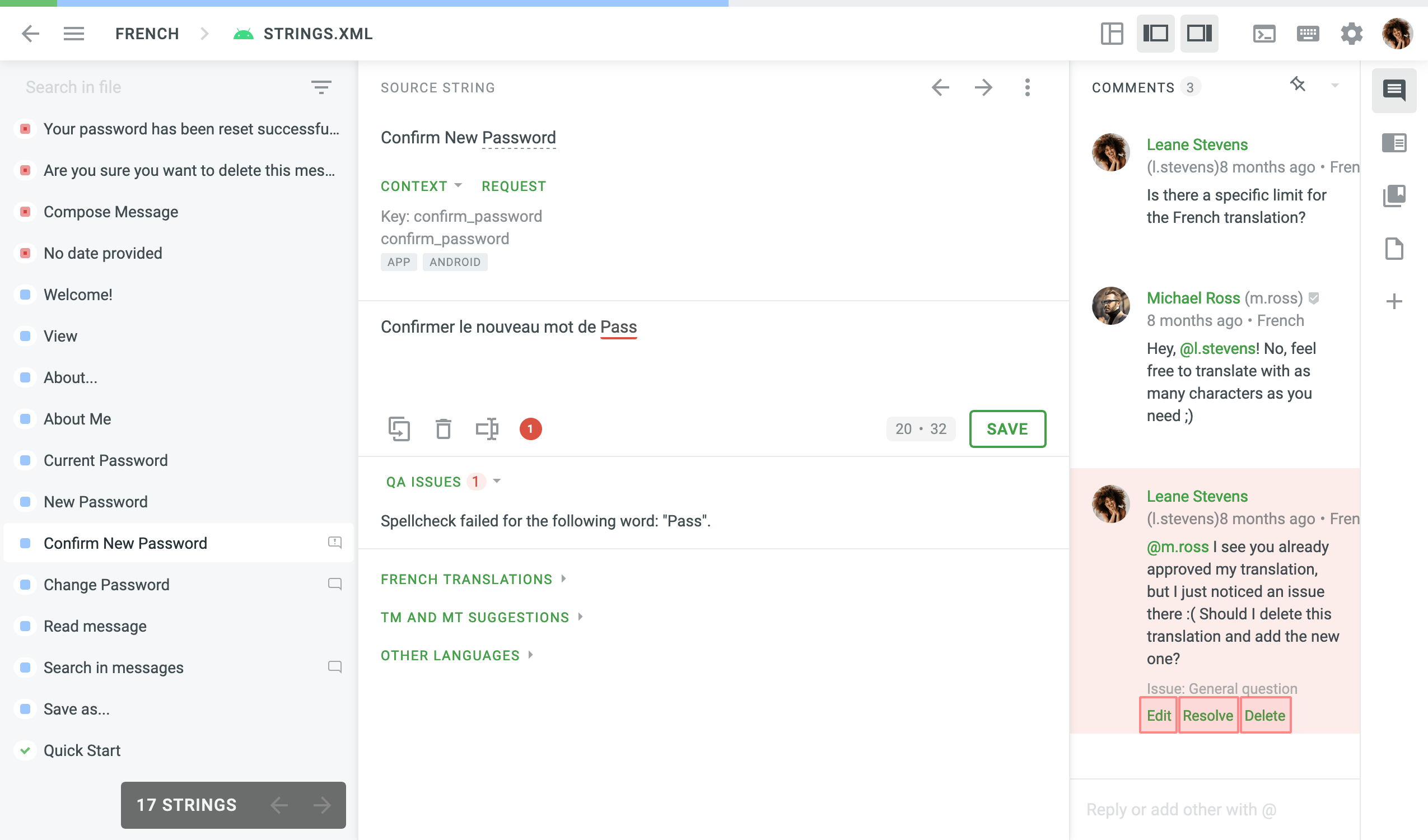
Se il proprietario o gestori del progetto hanno configurato l’integrazione con Jira, tutti i problemi segnalati saranno diretti al pannello di controllo di Jira per un’ulteriore elaborazione e risoluzione, senza la necessità di visitare l’Editor di Crowdin.
Read more about Jira Integration.
Cerca nella TM
Using the Search TM tab, you can check for all the available translations from Translation Memory, which is the vault of translations uploaded to the system by project managers.
La scheda Cerca TM fornisce le seguenti opzioni:
- Origine – Cerca corrispondenze in una lingua d’origine.
- Destinazione – Cerca corrispondenze nelle lingue di destinazione.
- Indovina la traduzione – Evidenzia la traduzione probabile di una frase di ricerca.
- Equivalenza numerica – Corrispondenza delle cifre da una frase di ricerca, con qualsiasi altra cifra.
Inoltre, per massimizzare i risultati della tua ricerca, puoi usare le seguenti wildcard con la tua frase di ricerca:
Type an asterisk (*) to find words where the end or beginning may be different. Example: any* finds any, anyway, anything Example: *way finds way, anyway, highway
Type a plus sign (+) to find words where the end or beginning must be different. Example: any+ finds anyway, anything, anywhere, except any Example: +way finds anyway, highway, someway, except way
Type a minus sign (-) to exclude words from your search. Example: Save -as
Use quotation marks to find the exact combination of words. Example: “Save as”
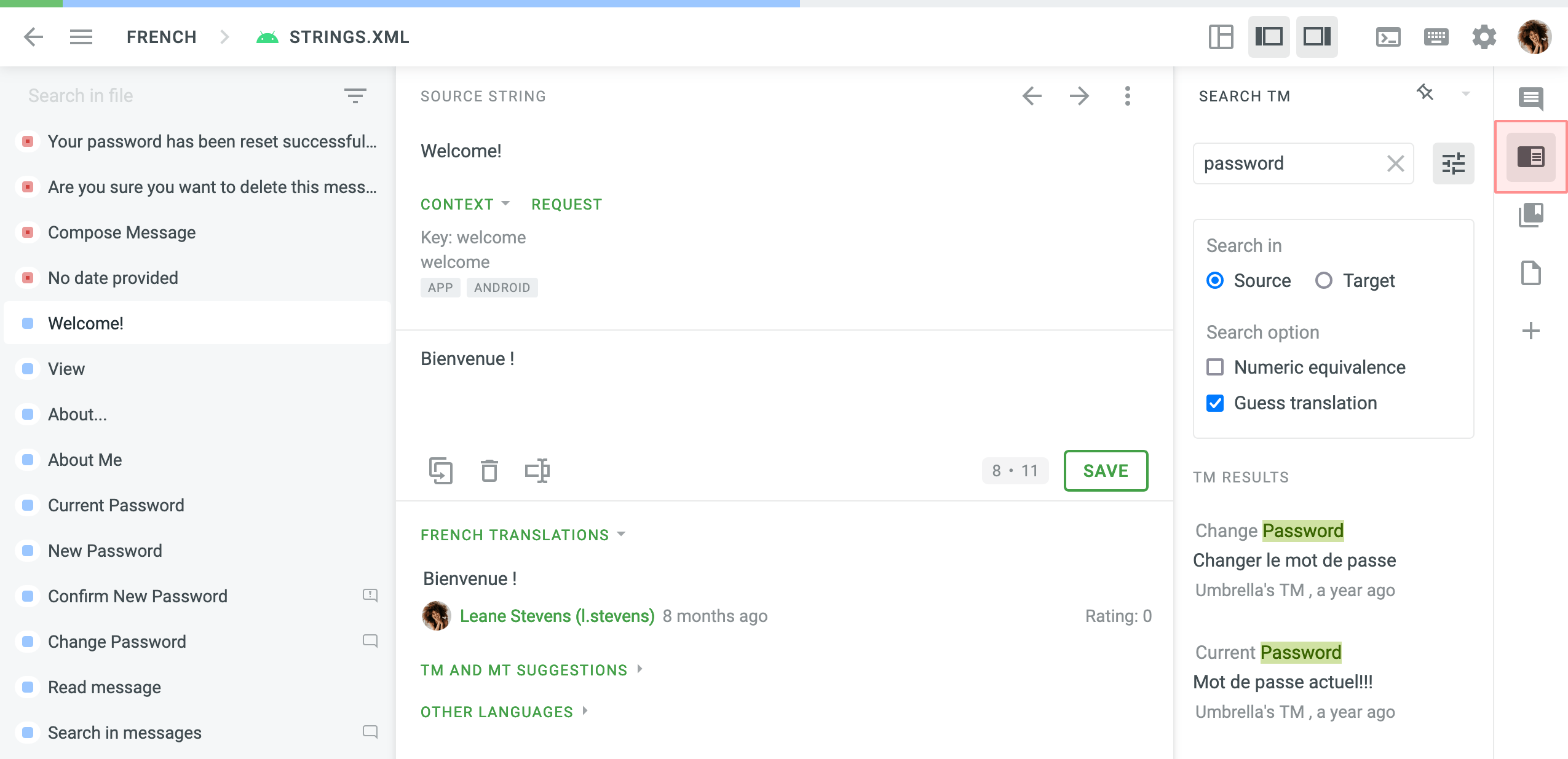
Editing TM Suggestions in the Editor
When working in the Editor, you can view the TM suggestions displayed in the TM and MT Suggestions section and in the right sidebar found through the Search TM tab. There may be situations where TM suggestions contain inaccuracies or need to be updated.
Project owners and managers with the appropriate permissions can edit or delete TM records directly in the Editor, both in the TM and MT Suggestions section and in the Search TM tab, rather than having to go to the Translation Memories page in the Resources or Project Settings. This ensures that TM suggestions are updated safely and quickly, improving the overall quality of the TM.
To edit the TM suggestion, follow these steps:
- Click
 in the TM and MT Suggestions section or Edit in the Search TM tab.
in the TM and MT Suggestions section or Edit in the Search TM tab. 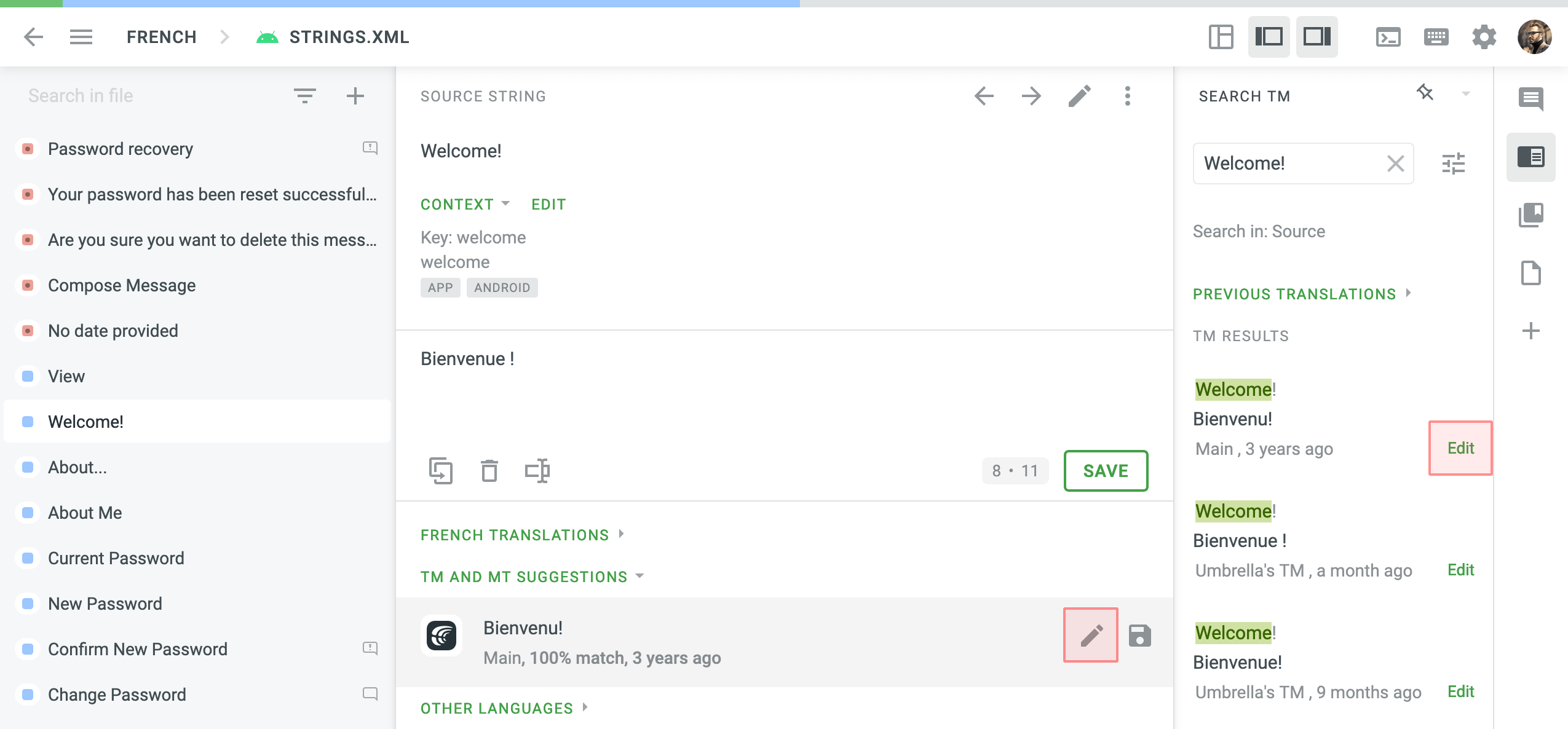
- In the appeared dialog, make the necessary edits (i.e., modify or delete) to the TM suggestions for each language present in the TM segment.
- To revert accidental deletions or unwanted changes, click Undo next to the TM suggestions or click Cancel to revert all modifications before saving.
- Once the desired edits are completed, click Save to confirm and apply these changes to the TM segment.
To completely delete a TM segment from the TM, delete all TM records across all languages and click Save.
Termini
Terms tab can be used to view the existing glossary available for the string (if any). You can also search for terms in the project glossary. If the specific term is not available in the project glossary, the system will show you Wikipedia explanations.
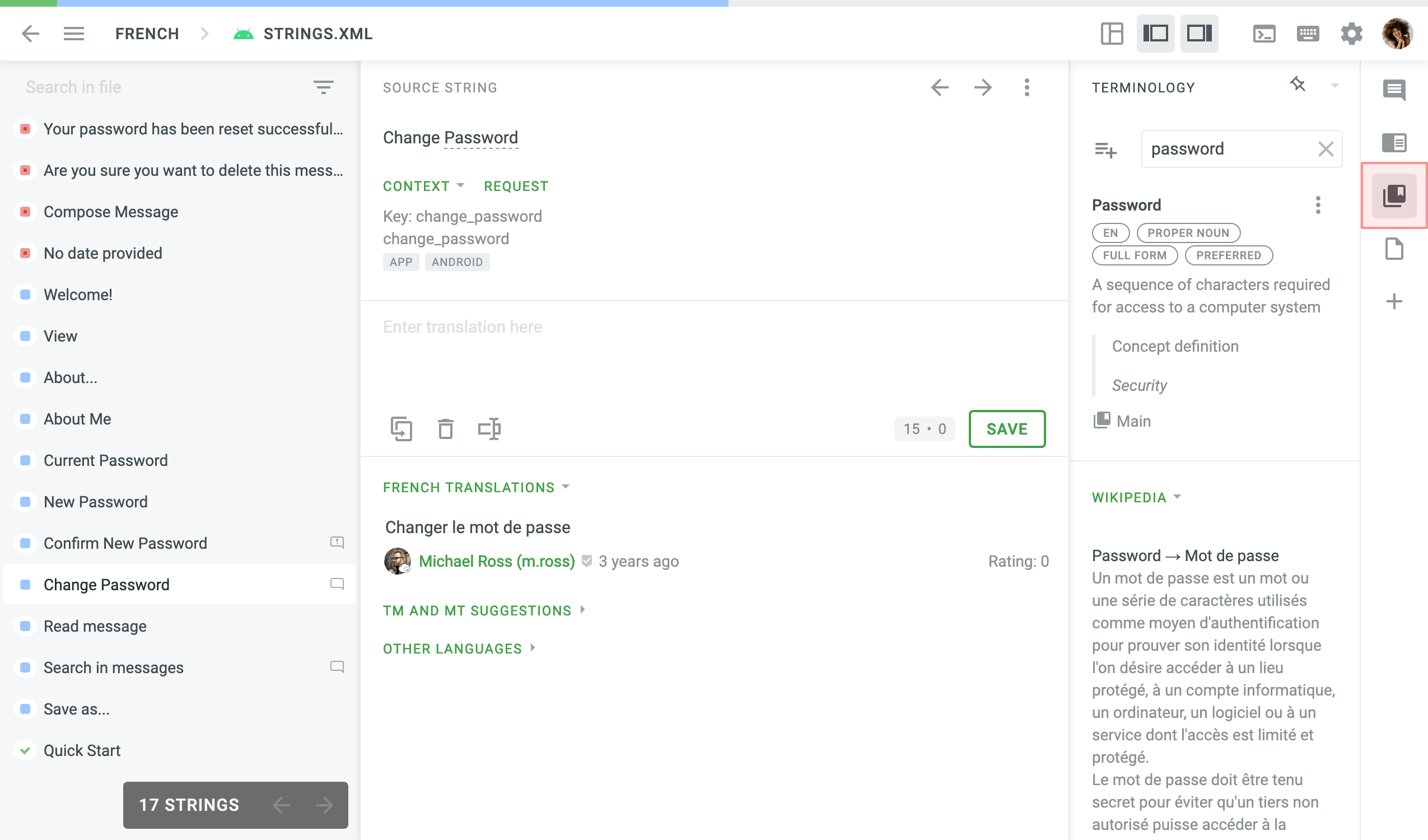
File Context
File Context tab can contain additional context or instructions for translators to better understand how to translate a particular file. File context can be added in the File Settings as plain text or Markdown by either an owner or a project manager.
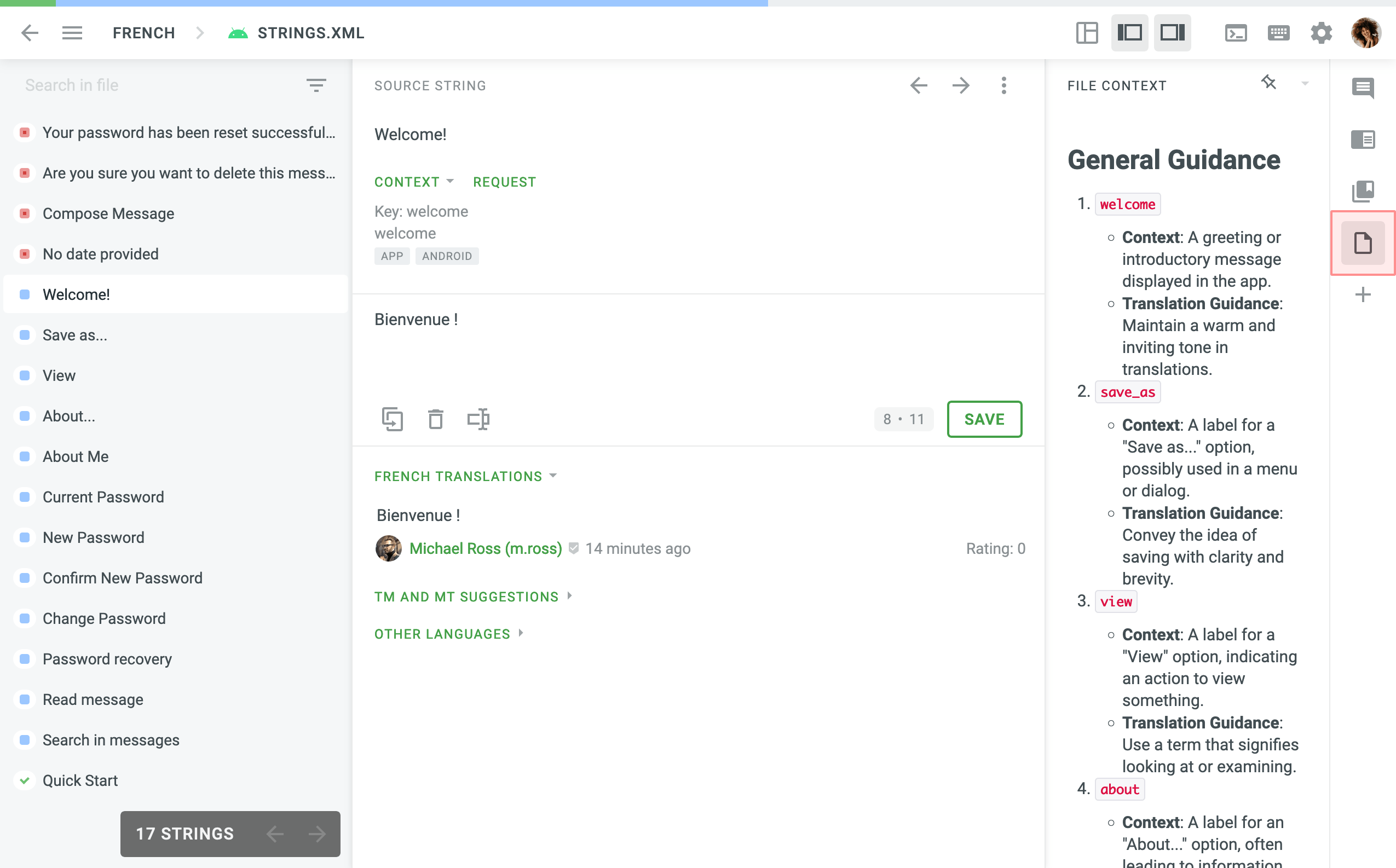
Modalità Side by Side
In Side-by-Side mode, translators can also translate, although this mode is mostly intended for comfortable voting for multiple best translations in a row, while managers and proofreaders can approve the best translations.
To switch to the Side-by-Side mode, click on the Main menu ![]() in the upper-left corner and choose View > Side-by-Side.
in the upper-left corner and choose View > Side-by-Side.
Per i traduttori
To vote, click the plus ![]() sign if you like the translation, or the minus
sign if you like the translation, or the minus ![]() sign if you don’t think the translation is correct. Translations that receive the most positive votes will have a higher rating and will appear at the top of all available translations for the string.
sign if you don’t think the translation is correct. Translations that receive the most positive votes will have a higher rating and will appear at the top of all available translations for the string.
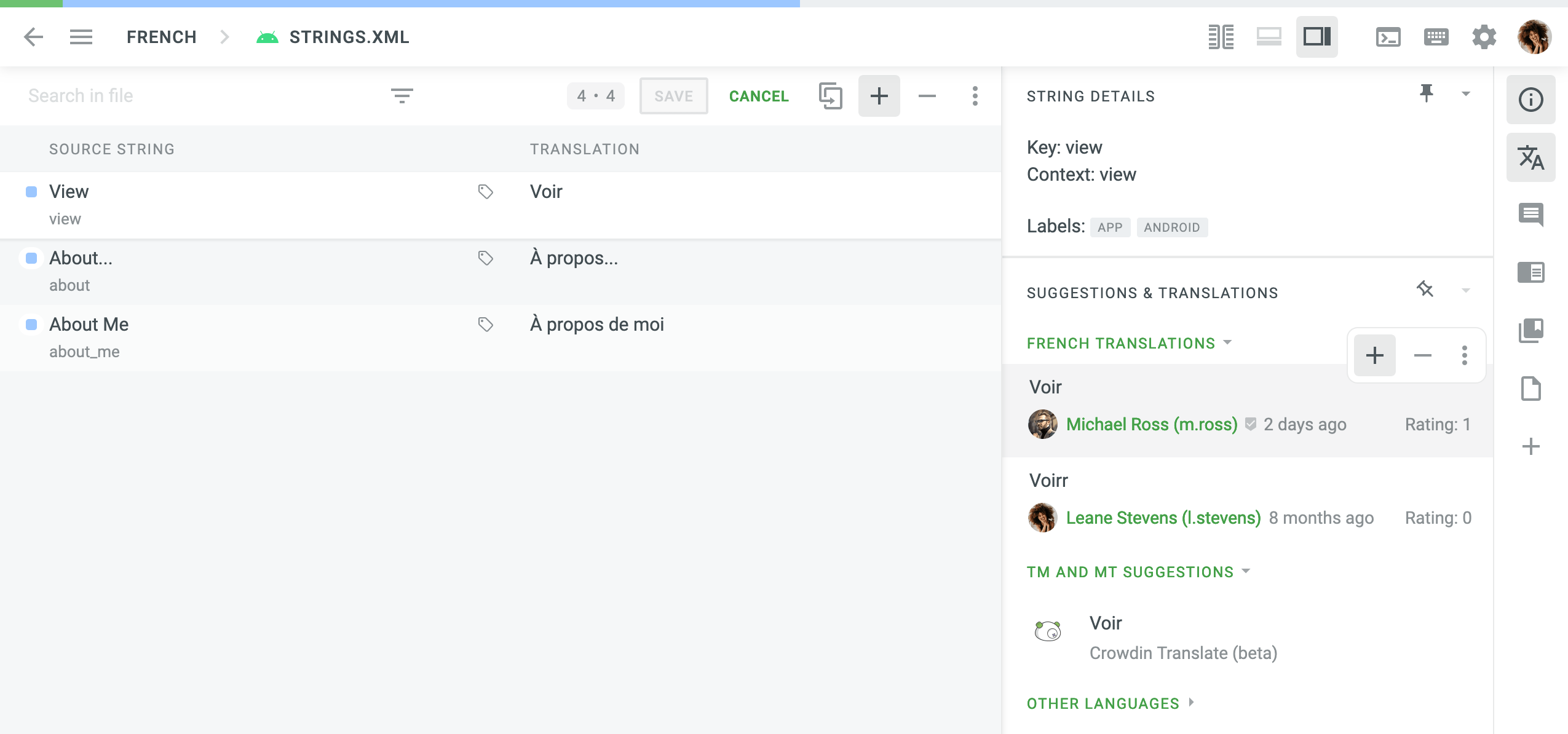
For Proofreaders
Review the translations to make sure they are ready for export, and click Approve ![]() icon next to the suggestion to approve each translation separately.
icon next to the suggestion to approve each translation separately.
Per approvare tutte o un paio di stringhe per volta, spunta le caselle sulla sinistra e poi clicca Approva.

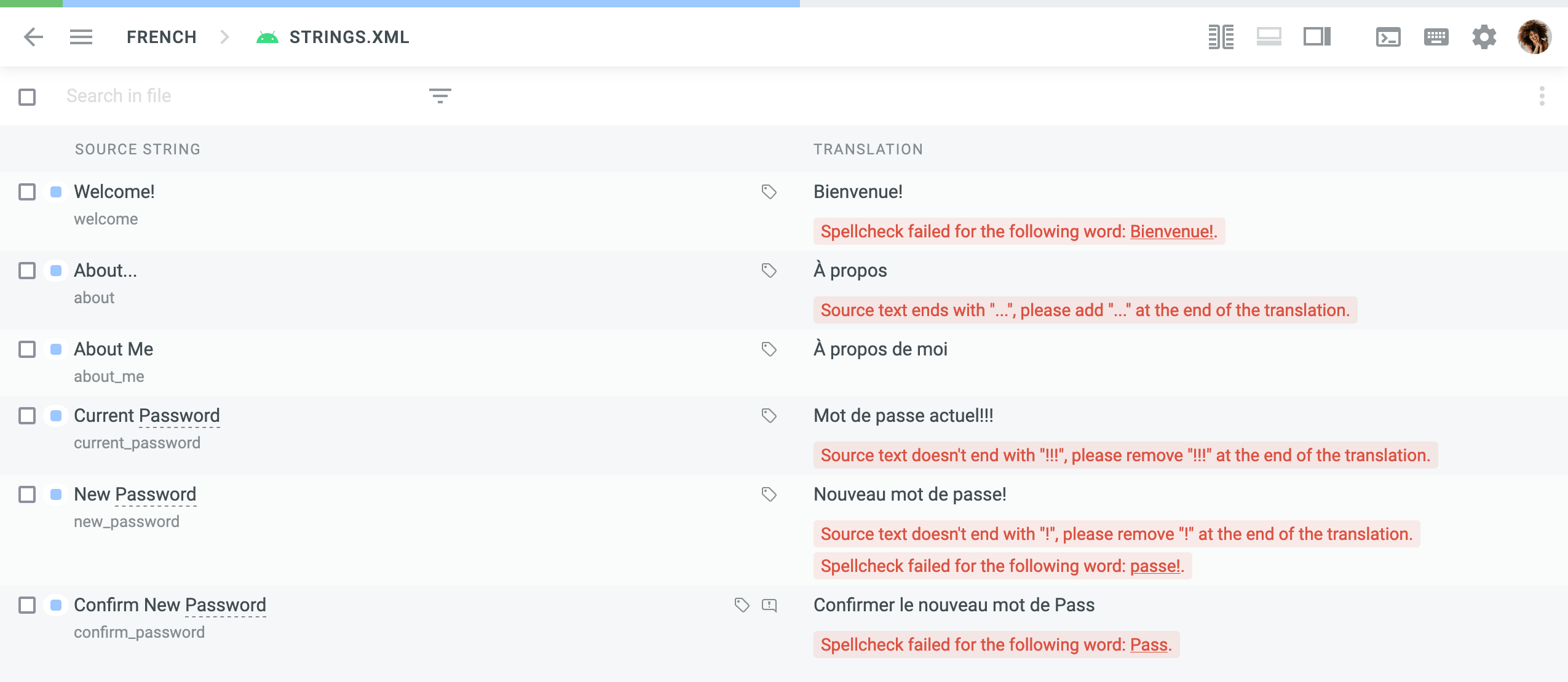
Suggesting Translations
To suggest another translation, сlick on the text you want to change, and when done, click Save. La tua traduzione sarà aggiunta all’elenco degli altri suggerimenti.

Modalità Multilingue
The multilingual mode provides similar features as the side-by-side mode and allows multilingual translators and proofreaders to work with multiple languages at the same time. You can select up to ten languages to work with simultaneously. The right panel shows the string’s translations of the language you’re entering a translation for or the one that was selected last.
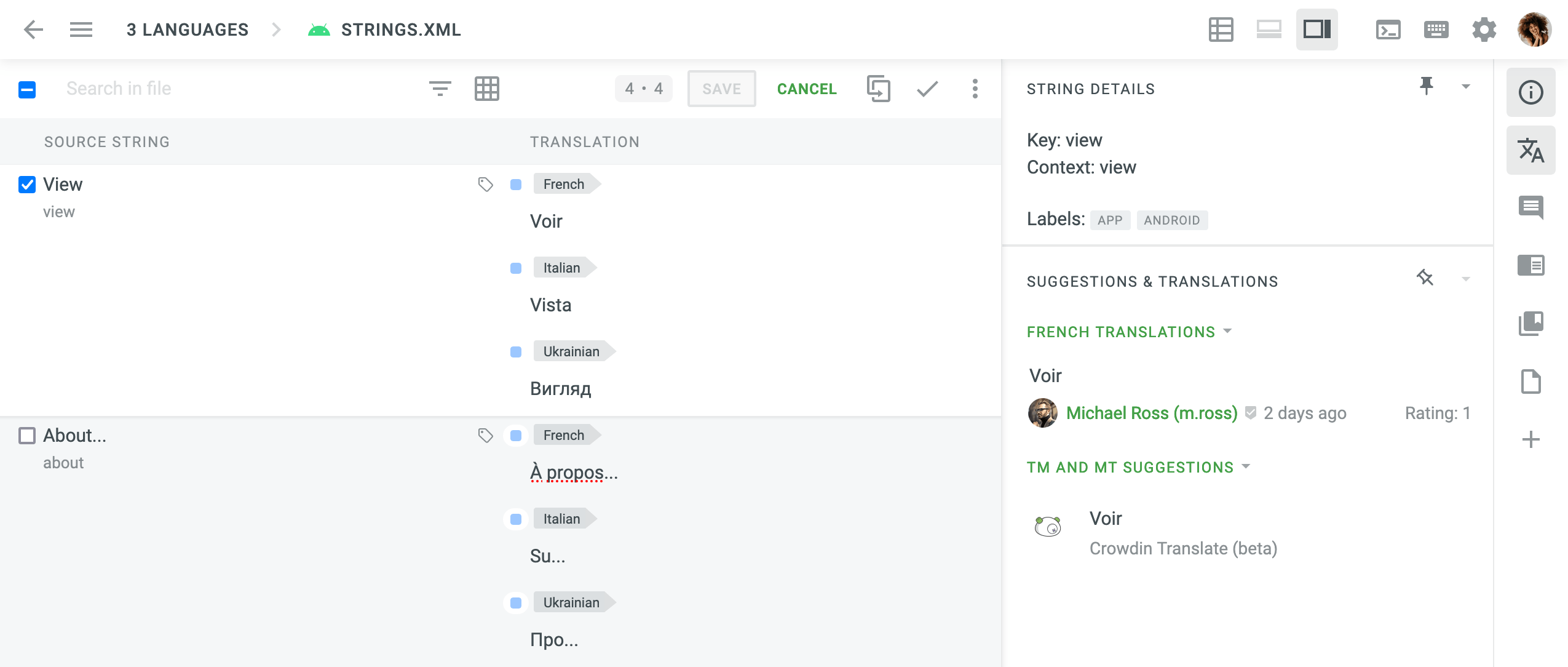
To switch to the multilingual mode, click on the Main menu ![]() in the upper-left corner, choose View > Multilingual, select the languages you’d like to work with, and click Apply.
in the upper-left corner, choose View > Multilingual, select the languages you’d like to work with, and click Apply.
To add new languages or remove some of the earlier selected ones, click on the Main menu ![]() in the upper-left corner, choose Language, alternatively click on the Languages in the upper-left corner, then do the necessary modifications to the language list and click Apply.
in the upper-left corner, choose Language, alternatively click on the Languages in the upper-left corner, then do the necessary modifications to the language list and click Apply.
When working in multilingual mode, you can switch between two possible views: List View, Grid View.
The List view is enabled by default. To switch to grid view, click ![]() in the upper-left corner. To adjust the columns displayed in the Grid view, click on the drop-down toggle in the upper-right corner and select the preferred ones.
in the upper-left corner. To adjust the columns displayed in the Grid view, click on the drop-down toggle in the upper-right corner and select the preferred ones.

For Proofreaders
The proofreading process works mainly the same way as in side-by-side mode, except when approving or removing approvals for all or a couple of strings at once, the system performs the action for all languages selected for the multilingual mode.
Using Filter in Multilingual Mode
When using filter options in multilingual mode, the system will show strings that meet the selected criteria for at least one of the selected languages.
This behavior applies to the following filter options:
- Non tradotto
- Non Approvata
- Approvata
- Problemi QA
- Machine Translations
- Filtro Avanzato > Traduzioni aggiornate
- Filtro Avanzato > Traduzioni > Plurali parzialmente tradotti
- Filtro Avanzato > Traduzioni > Come la stringa sorgente
- Filtro Avanzato > Voti
Tradurre Lingue RTL
When translating between LTR and RTL languages, some elements in the translation field in the Editor might not be displayed the same way as they will be once exported.
To be sure that RTL translations will be displayed correctly in the exported file, we recommend making translations the following way:
- Clicca
 sotto il testo sorgente (o la combinazione di tasti Alt+C).
sotto il testo sorgente (o la combinazione di tasti Alt+C). - Traduci i testi sorgente nella lingua di destinazione.
- Leave variables, tags, etc., unchanged in the translation, even if they look wrong. They will be in the right positions in the exported file.
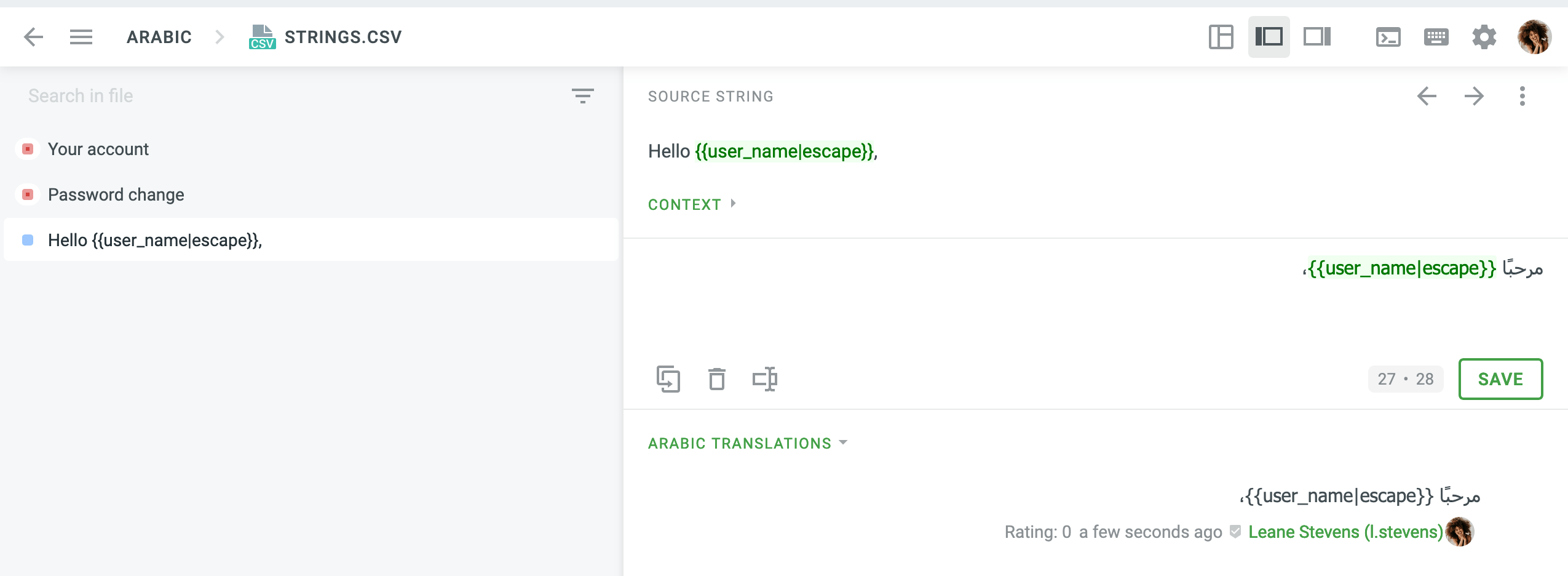
For cases when you need to provide bidirectional translations (e.g., strings with placeholders), we recommend using the Unicode Table app, with the help of which you can copy and paste right-to-left and left-to-right marks to the translation field, changing the direction of text where needed.
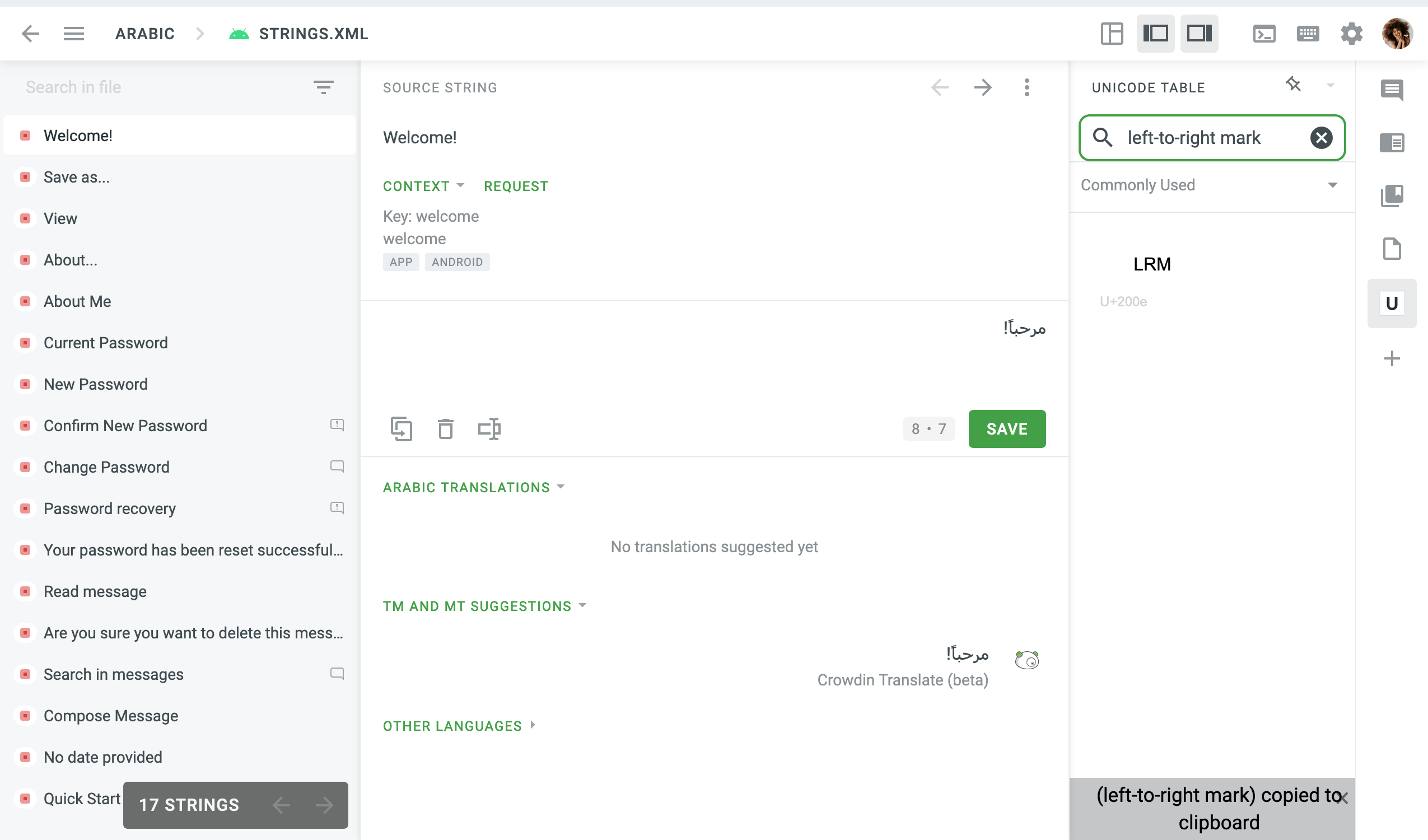
Command Palette
The Command Palette in the Editor is your hub for accessing various commands efficiently. It serves as a central location for all available commands, ensuring a seamless and intuitive experience.
To open the Command Palette, click ![]() in the upper-right corner.
in the upper-right corner.
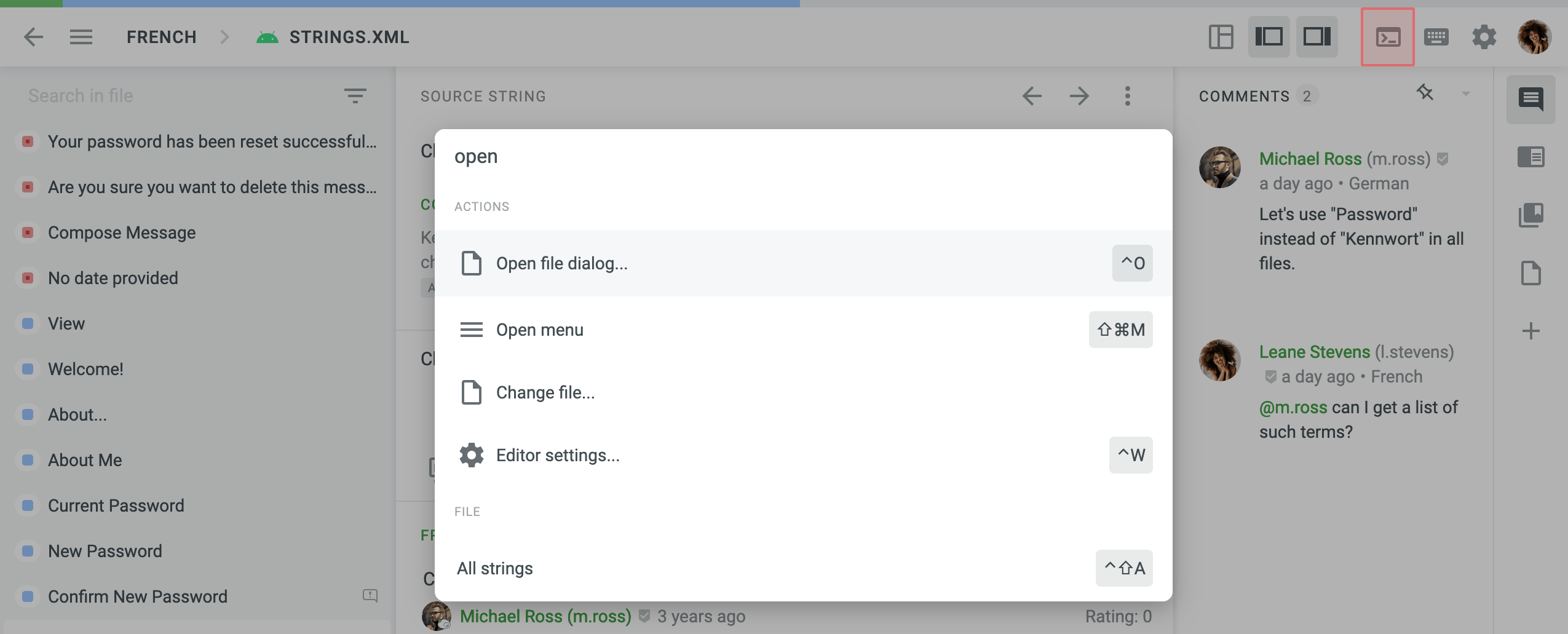
Impostazioni dell’Editor
To open the Editor settings, click ![]() in the upper-right corner.
in the upper-right corner.

Editor Settings include the following options:
- Suggerimenti della Memoria di Traduzione – puoi specificare la corrispondenza di similarità minima (in percentuale) per i suggerimenti della memoria di traduzione, mostrati sotto il campo di traduzione.
- QA checks – if enabled, the pop-up messages with warnings will appear each time you try to save a translation with some inaccuracy (punctuation/tags/spaces mismatch, missing variables, etc.)

- Auto-complete – if enabled, the pop-up with translation prediction and automatic translation completion will appear while you type the translation.
- Auto-approve – if enabled, the translations added by proofreaders or members with higher permissions are automatically approved.
- Automatically move to next string – if enabled, you’ll be automatically moved to the next string after saving a new translation or approving an existing one.
- Themes – set the Light or Dark theme, or select Auto to allow the Editor to set the theme based on your device system settings.
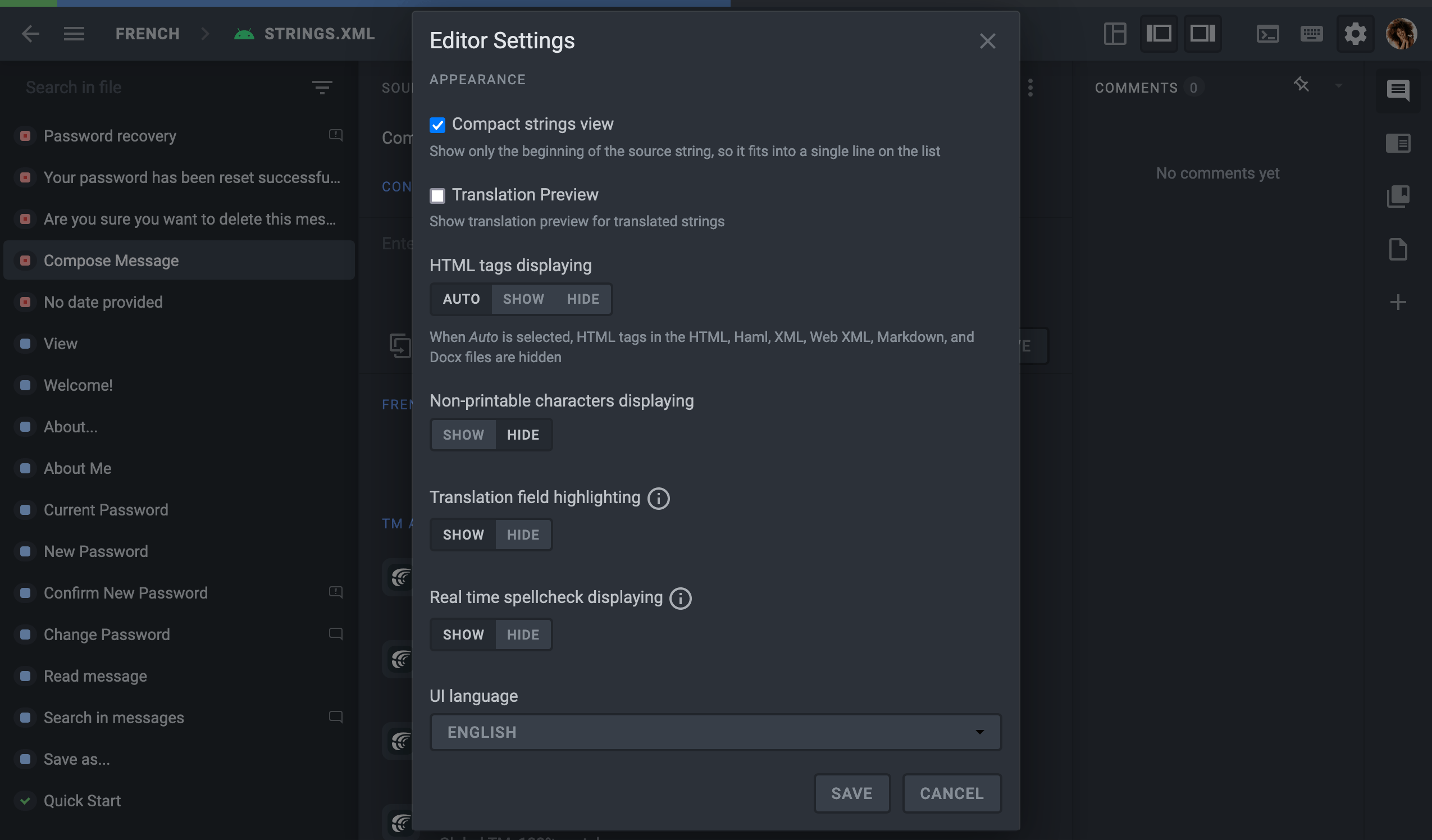
- Compact strings view – if enabled, only the beginnings of the long strings will be shown in the string list.
- Translation Preview – if enabled, a translation preview will be displayed for translated strings in the string list.
- Visualizzazione dei Tag HTML – puoi scegliere l’opzione Mostra o Nascondi, che si applica a tutti i tag HTML. If you choose Auto, tags will be hidden in HTML, Haml, XML, Web XML, Markdown, and DOCX files but shown in other file formats. When tags are hidden, you can expect the following:
<a href="https://sample.com">Esempio</a>sarà sostituito con
<0>Esempio</0> - Non-printable characters displaying – if enabled, non-printable characters (e.g., space, tab character, line break, etc.) will be displayed in source texts and translations.
- Translation field highlighting – if enabled, words with potential QA issues will be underlined in the translation field.
- Real time spellcheck displaying – instantly view spelling issues as you type a translation. Currently, this feature is available for selected languages.
- UI Language – select your preferred language for the Crowdin UI. The chosen language will be applied to the Editor and other parts of Crowdin.
Helpful Tips
- Scorciatoie da tastiera
- Accesso rapido alle schede del menu
- Utili opzioni per le parole sorgente
- Passare a Un Altro File
- Sostituisci le Traduzioni Suggerite
- Replace in Sources
- Filtro Avanzato
Scorciatoie da tastiera
Usa le scorciatoie da tastiera per compiere rapidamente le azioni nell’editor. Check the list of keyboard shortcuts by clicking the keyboard ![]() icon in the upper-right corner. Check the list of keyboard shortcuts by clicking the keyboard
icon in the upper-right corner. Check the list of keyboard shortcuts by clicking the keyboard ![]() icon in the right upper corner. Clicca sulla combinazione di tasti necessaria, e modificala con l’aiuto della tastiera.
icon in the right upper corner. Clicca sulla combinazione di tasti necessaria, e modificala con l’aiuto della tastiera.
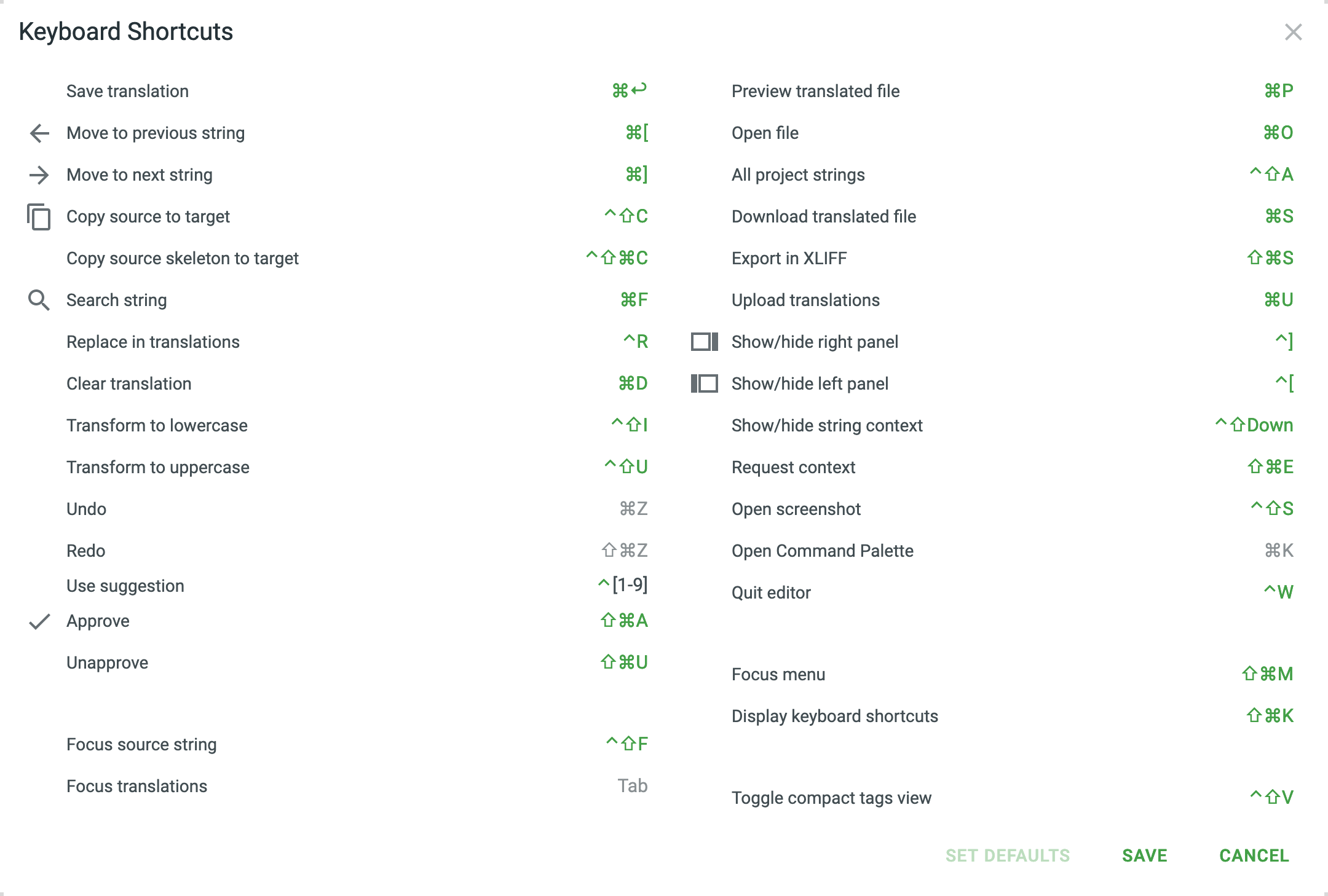
Quick Access to Menu Tabs
Accesso facilitato agli elementi del menu più usati in un click:
- Lingua – clicca sulla lingua corrente (francese nel seguente screenshot)
- File – clicca sul nome corrente del file (impact.xml nel seguente screenshot)

Useful Options for Source Words
Per controllare i suggerimenti della Memoria di Traduzione per una parola o frase in particolare, selezionala nella stringa d’origine e scegli Cerca TM dal menu. Puoi anche cercare la spiegazione di una parola o frase nella terminologia del progetto ed in Wikipedia.

Passare a Un Altro File
Per tradurre le stringhe da altri file, segui questi passaggi:
- Click on the Main menu
 or click on the current file name in the upper-left corner.
or click on the current file name in the upper-left corner. - Scegli File > Apri.
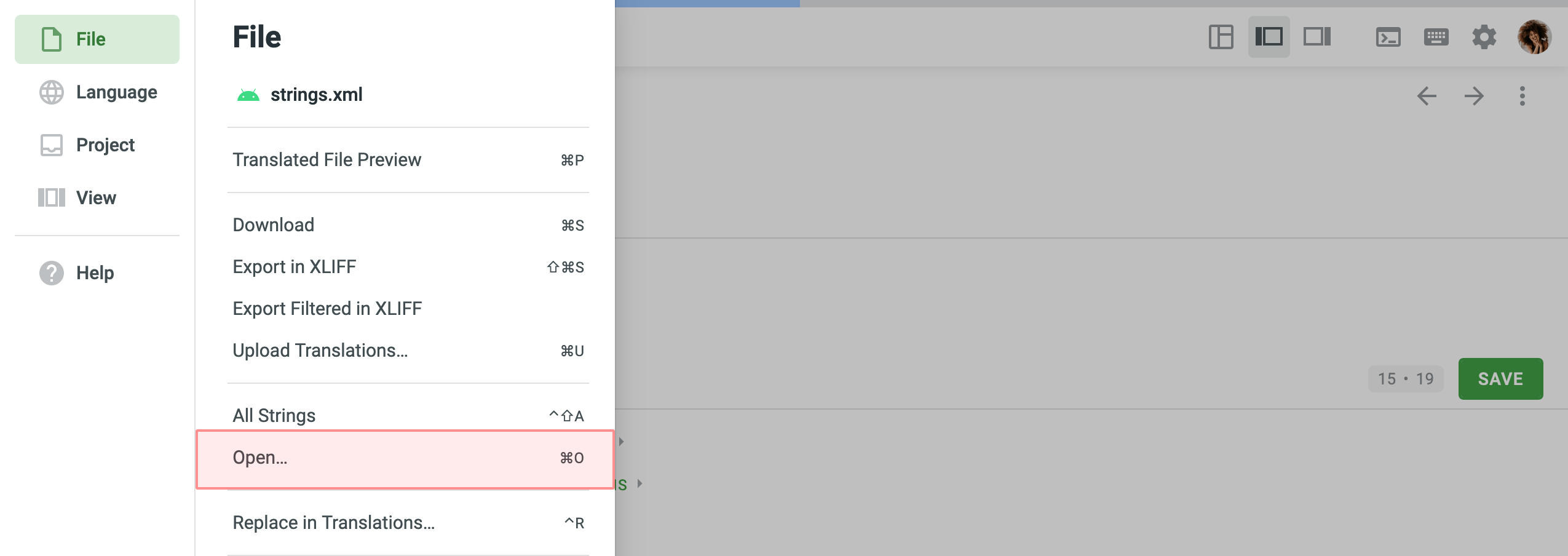
- Seleziona il file necessario e clicca Apri. Alternatively, just double-click on the necessary file.
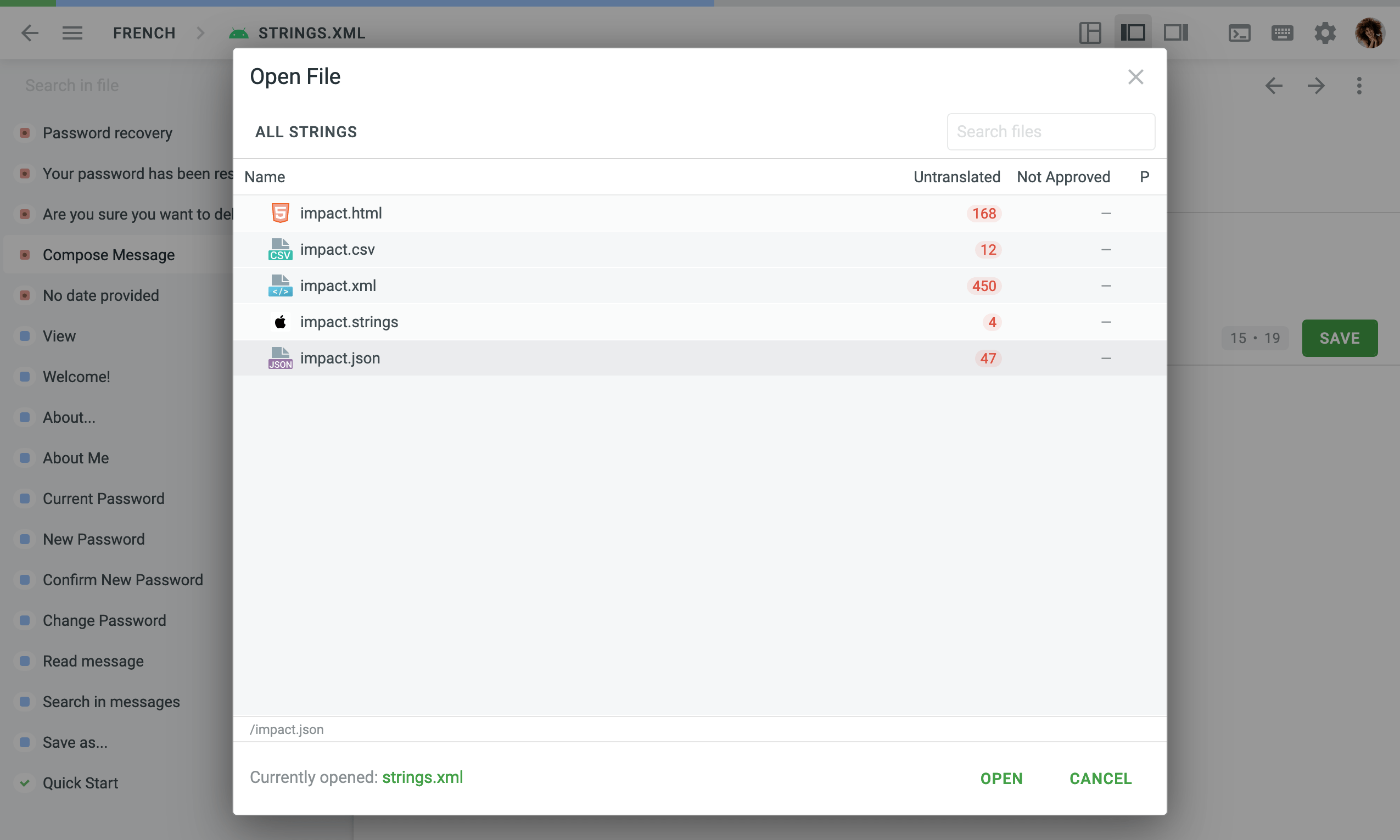
To see all strings of the project, click on the Main menu ![]() in the upper-left corner, and go to File > All Strings. Alternatively, click on the current file name in the upper-left corner > All Strings.
in the upper-left corner, and go to File > All Strings. Alternatively, click on the current file name in the upper-left corner > All Strings.
Sostituisci le Traduzioni Suggerite
Puoi facilmente trovare e rimpiazzare le traduzioni suggerite usando la funzionalità Rimpiazza in Traduzioni.
To replace previously added translations with the new ones, follow these steps:
- In the project Dashboard tab, select the necessary language.
- Click Translated All or choose a file for translation.
- Click on the Main menu
 in the upper-left corner.
in the upper-left corner. - Vai a File > Sostituisci nelle Traduzioni.
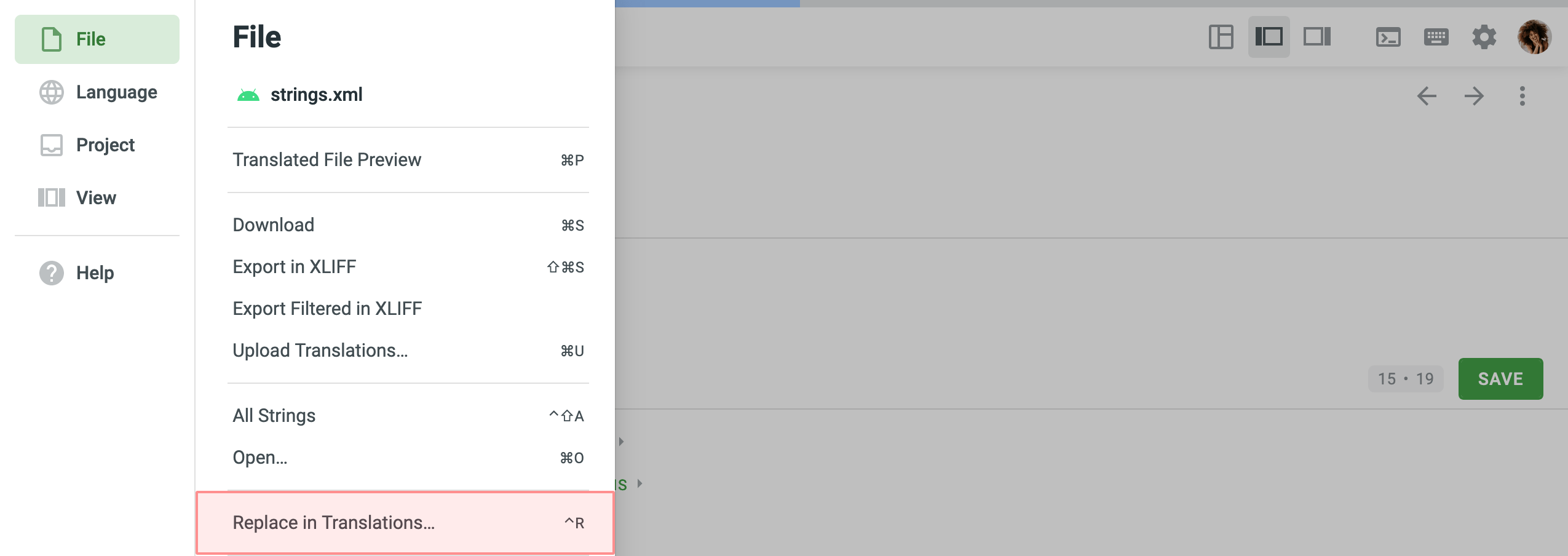
- Enter the word, phrase, or sentence you want to substitute and the text to replace it with. Similarly to string search, you can use the Match case and Exact match options to refine the search results.
- From the drop-down menu, specify the scope of your search, selecting between File, All files, or Filtered strings options.
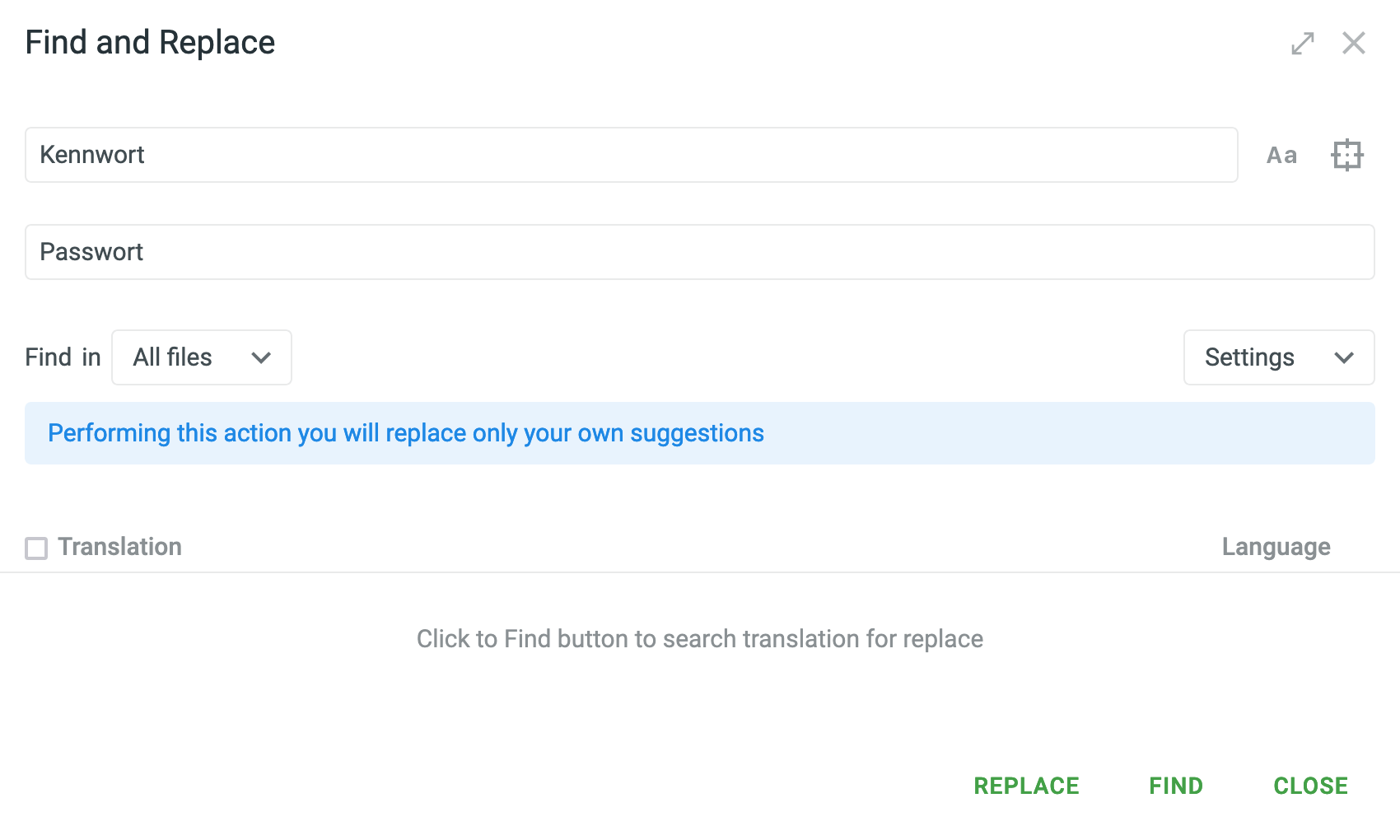
- Click Find to preview the strings that will be replaced.
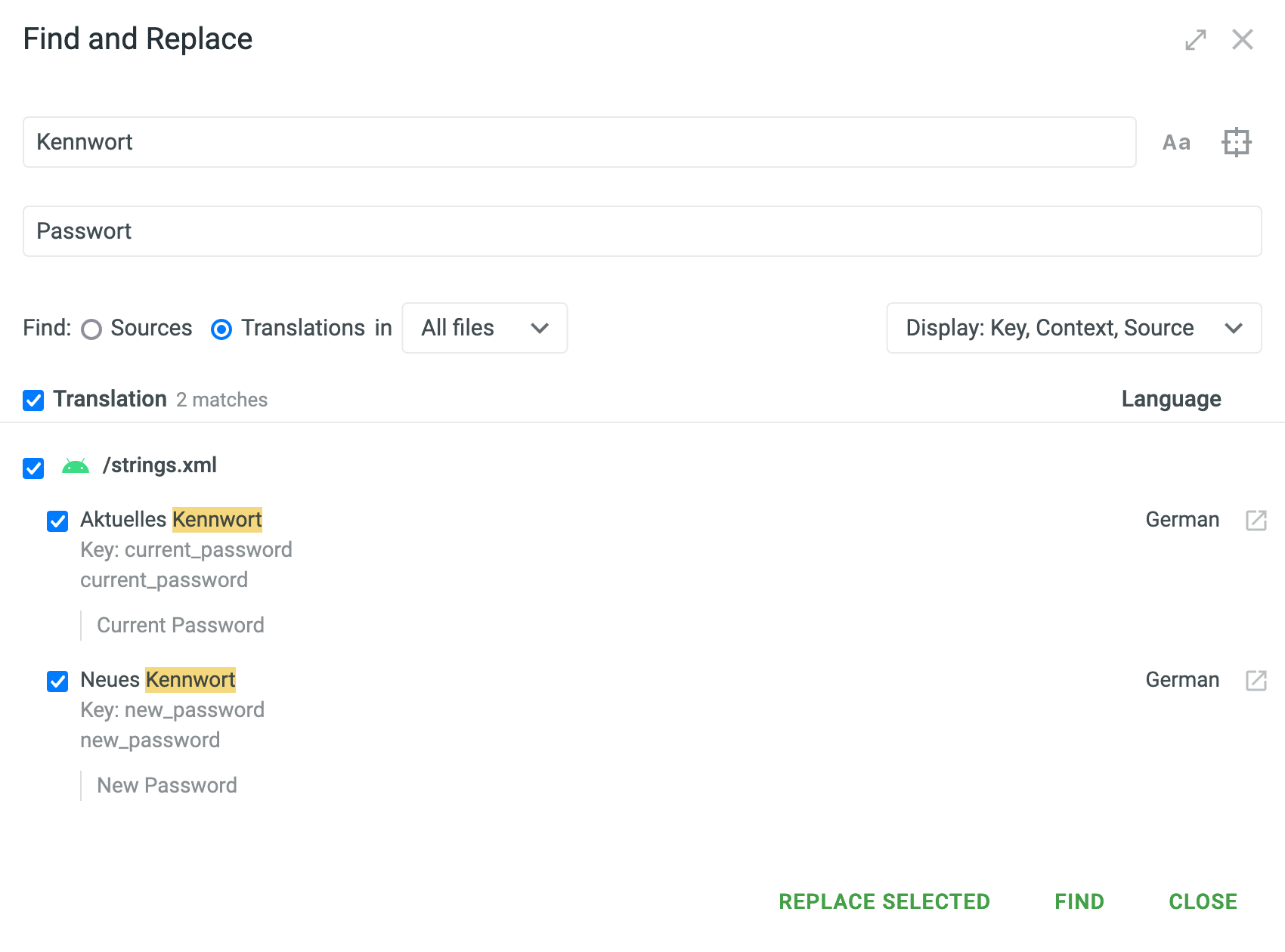
- (Optional) Click the Settings drop-down menu on the right and select what information to display in the search results other than translations. You can choose between Key, Context, and Source.
- Select the translations you want to replace and click Replace Selected to finish.
While translators can perform replacements only in their own translations, project members with proofreader permissions (or higher) can modify all suggested translations. Authorship of translations is preserved.
Replace in Sources
Project members with developer permissions (or higher) can find and replace source texts using the Replace in Sources feature.
To replace source texts, follow these steps:
- In the project Dashboard tab, select the necessary language.
- Click Translate All or choose a file for translation.
- Click on the Main menu
 in the upper-left corner.
in the upper-left corner. - Go to File > Replace in Sources.
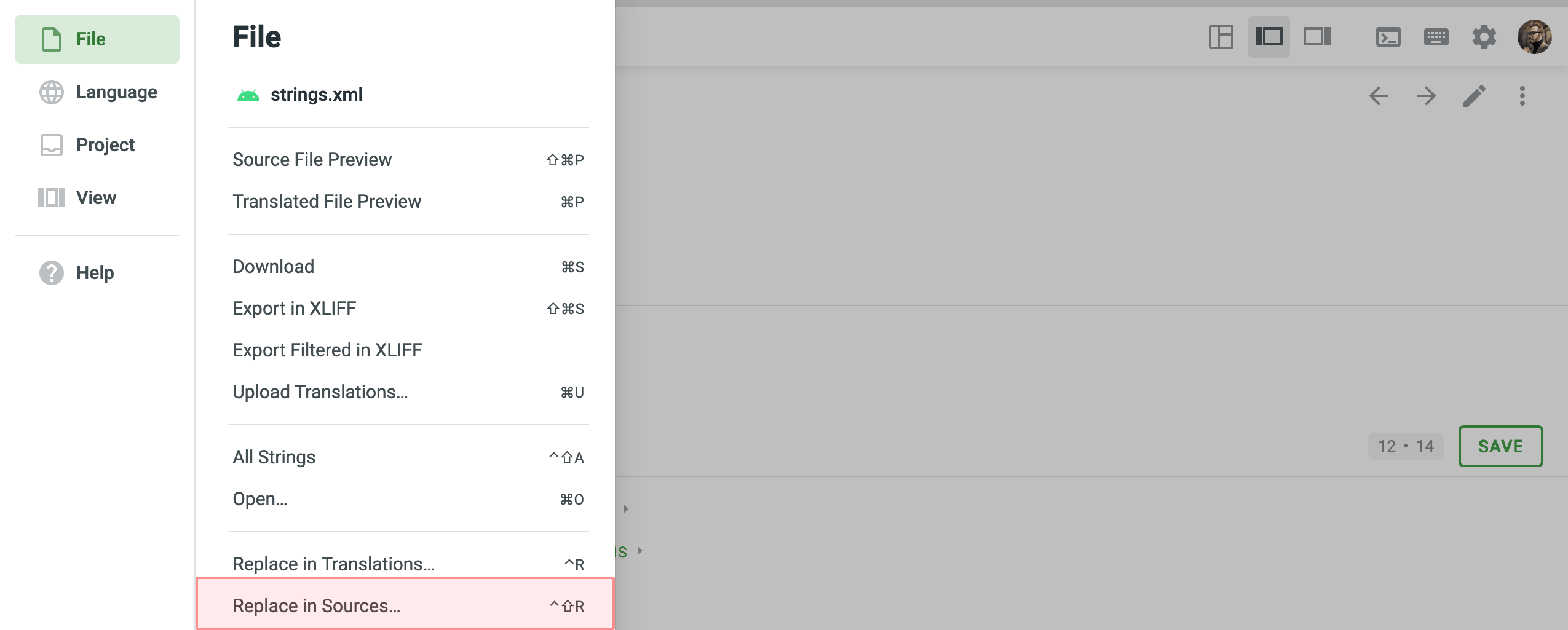
- Enter the word, phrase, or sentence you want to substitute and the text to replace it with. Similarly to string search, you can use the Match case and Exact match options to refine the search results.
- From the drop-down menu, specify the scope of your search, selecting between File, All files, or Filtered strings options.
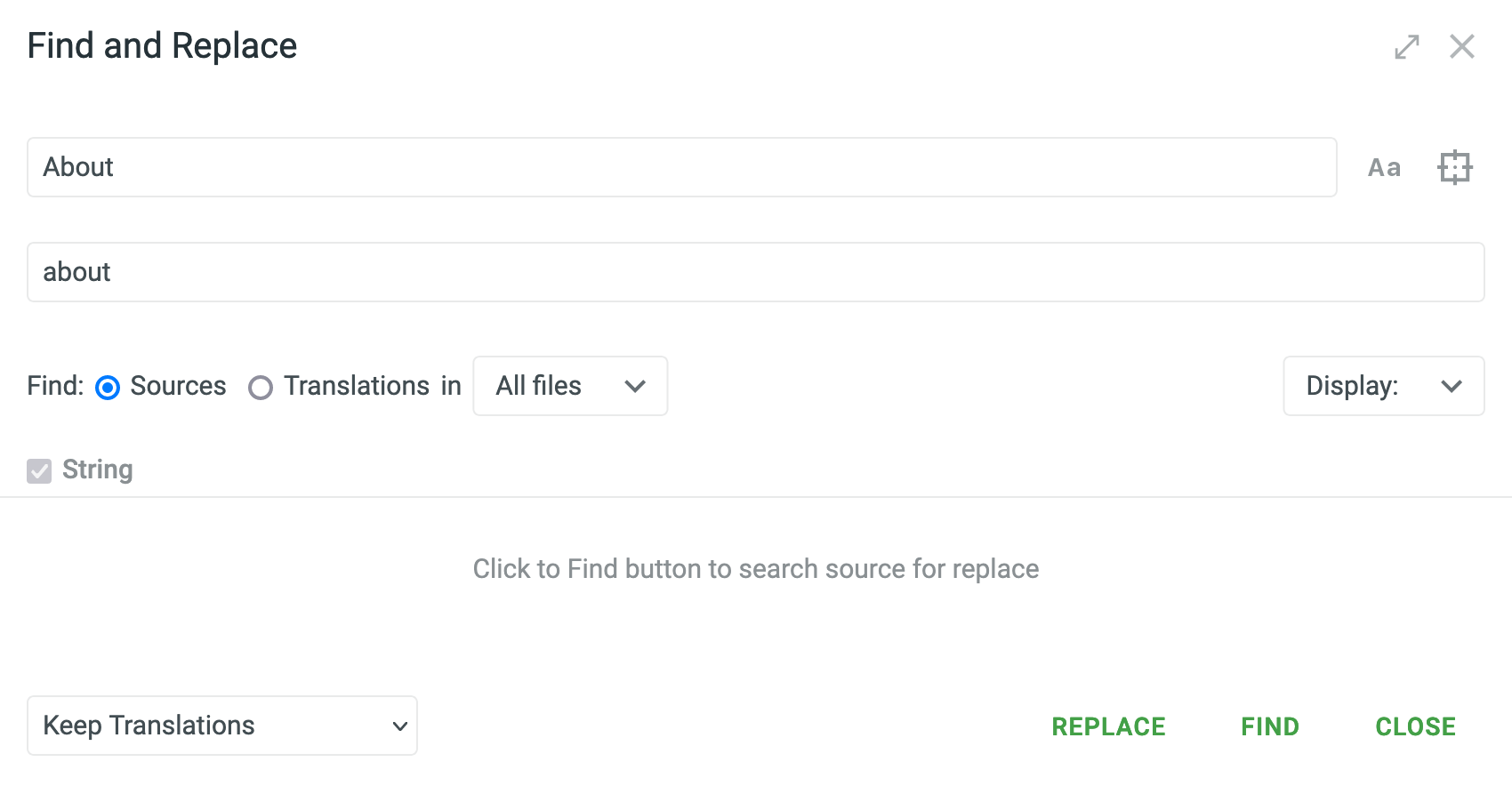
- Click Find to preview the strings that will be replaced.
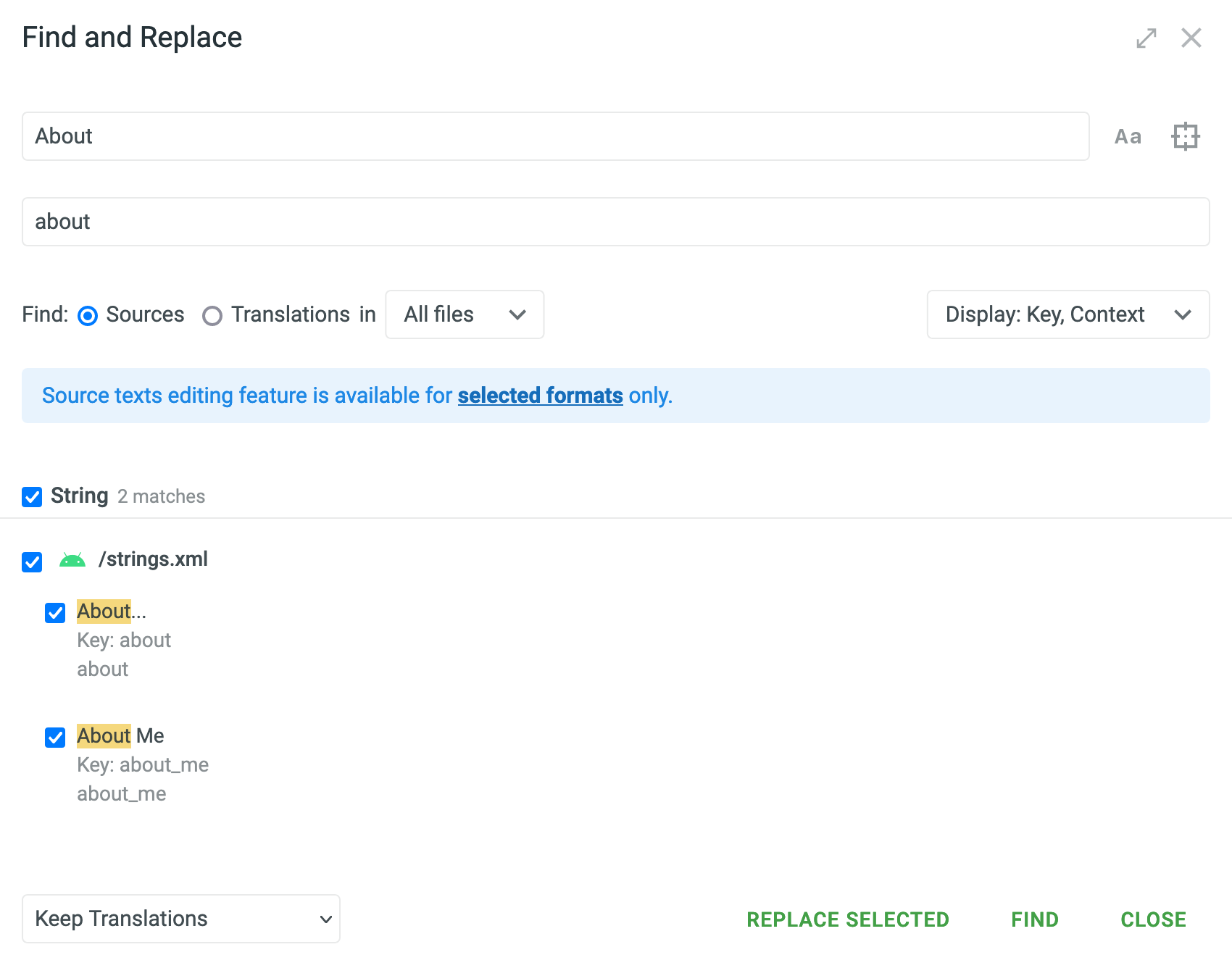
- (Optional) Click the Settings drop-down menu on the right and select what information to display in the search results other than strings. You can choose between Key and Context.
- In the lower-left corner, click the drop-down menu and select the preferred behavior for the translations of the source strings to be replaced. You can choose between Keep Translations, Remove Approvals, or Delete Translations.
- Select the source strings you want to replace and click Replace Selected to finish.
Filtro Avanzato
You can create a custom filter of strings by clicking the Filter strings ![]() icon and choosing Advanced Filter.
icon and choosing Advanced Filter.
You can choose multiple filter parameters (e.g., strings added, strings updated, translations updated, Labels, and more) based on your specific needs to sort the strings. Questo potrebbe aiutare a trovare le informazioni necessarie, molto più velocemente.
In the below screenshot, you may see the strings are filtered by Translations updated interval, the Labels that the filtered strings should be marked with, the Comments, Visibility, and Approved by parameters as well as sorted by Alphabet in Descending order. 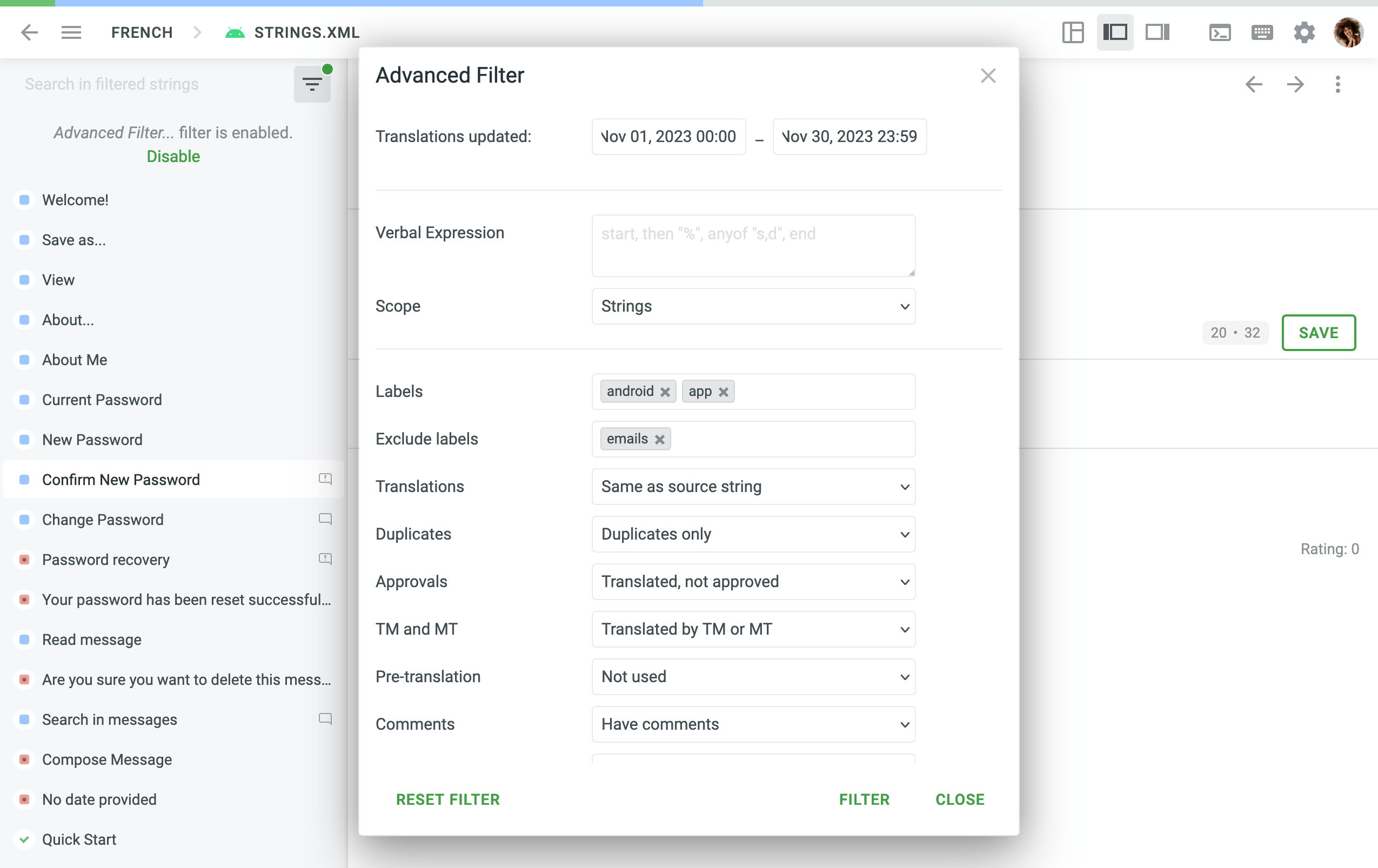
Attività nell’Editor
Una volta che un traduttore o proofreader ha un’attività assegnata, tutti i dettagli dell’attività sono accessibili dall’editor:
- The name of the task is displayed at the top of the toolbar.
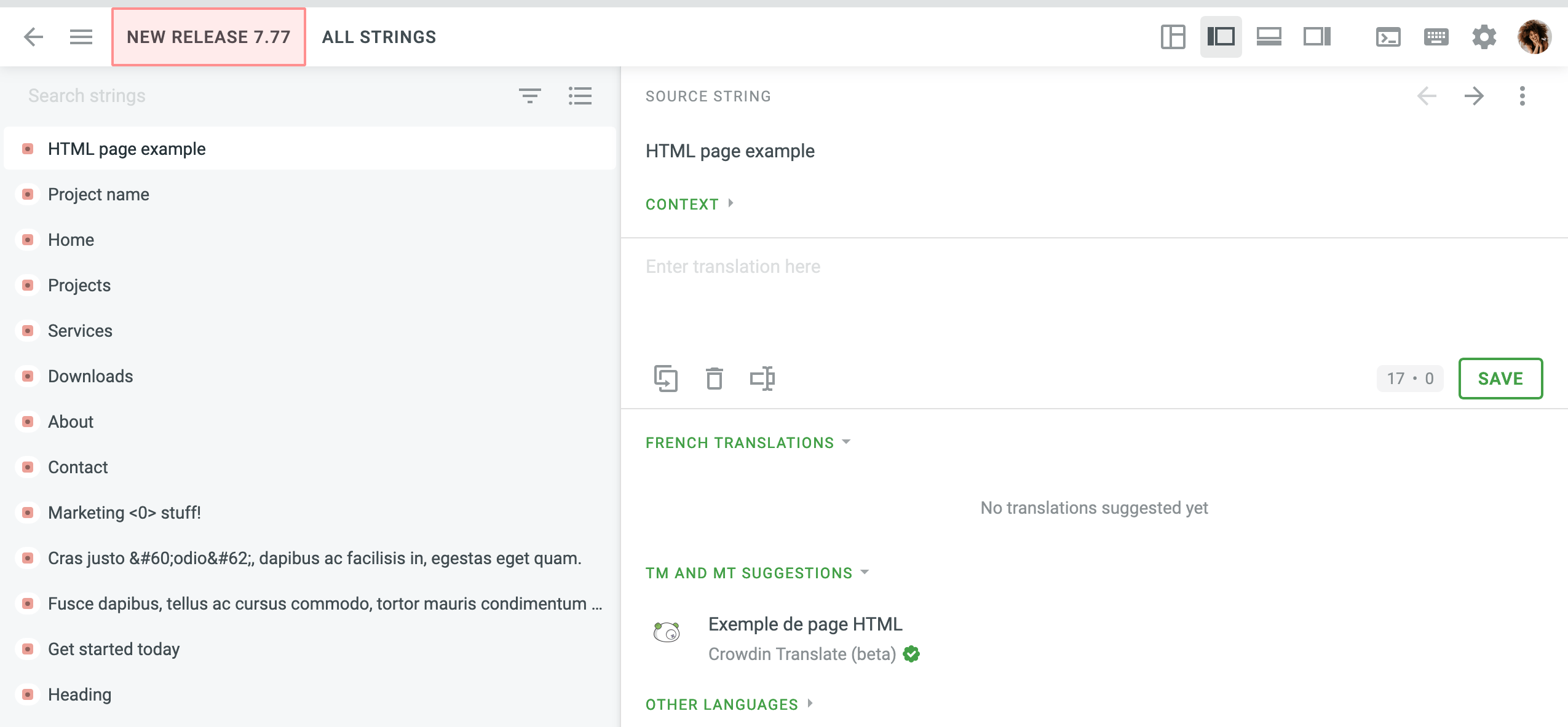
- Filtri e ricerche si applicano solo a un’attività particolare.

- Task details can be accessed by clicking the menu in the upper-left corner.

The task menu consists of the following components and features:
- name, due date, language, type of the task, and assignee
- opzioni per scaricare e caricare traduzioni per l’attività particolare
- possibility to quit the particular task editor and show all project strings
- Replace in Translations option
- Replace in Sources (only for project members with developer permissions (or higher))
